














Starting with this year’s freshman class, East is implementing a new vocabulary curriculum in English classes that will now be mandatory. The new curriculum no longer relies on the green “Building an Enriched Vocabulary” book that decades of East students were taught with. Instead, the new curriculum centers around “in-context vocabulary” and will develop vocabulary units that coordinate with the books students read over the course of the year.
“The initiative is to connect the [vocabulary] words with the specific book that we’re reading in class,” said Ms. Janine Cooney, who teaches the freshman English 1H class. This approach is designed to help students
better understand the literature they are reading, said Cooney, while also enhancing their vocabulary. Under the new curriculum, each vocabulary unit will focus on a list of words pulled from the book students are currently reading in class. For example, Cooney’s English 1H students studied vocabulary from “Jane Eyre” for their first unit of the year, including words such as “stout,” “infantine,” “sanguine,” “emulation” and “vignettes.” However, even with the new method, teachers are noticing that many of the in-context vocabulary words introduced this year are also found in
the word lists of the old vocabulary book.
“We are seeing that there is definitely an overlap,” said Cooney.
For each vocabulary word, students are assigned tasks such as identifying the sentence in the book in which the word is used; defining the word in context (that is, defining how it is used in the book); and writing their original sentence using the word. In addition,
the new curriculum will also focus more on root and prefix studies to improve students’ ability to tackle unfamiliar words.
As the school year began, the new curriculum seemed promising from what Cooney saw from her students’ performances on their first test of the year.
“[At first], there was some resistance among the English department because we’ve been doing [the old] vocab for so long and feel that we had done pretty well with teaching it and preparing [students] for the SATs,” said Cooney. “We were a bit hesitant to try [the new curriculum] at first but we hope to continue to see positive results.”
According to Cooney, the new vocabulary curriculum had already been in the works for a few years: a curriculum committee with
teachers from both East and West had been exploring possibilities for new ways to teach vocabulary and some teachers had also been piloting their own vocabulary programs.
This year, the new incontext vocabulary curriculum only applies to the freshman class, and the upper grades coming into East will continue to use the green “Building an Enriched Vocabulary” book.

However, the district plans to slowly phase out the old curriculum and only use the in-context vocabulary approach with students in the future. By the time the class of 2025 graduates, all East students are expected to be learning the new in-context vocabulary curriculum.
Beginning with this year’s fifth grade class, the Rosa International Middle School lottery system will be removed. All fifth grade students will be assigned a middle school to attend based on their current elementary schools.
With the new redistricting plans, J. F. Cooper, Bret Harte, Joseph D. Sharp and Richard Stockton elementary schools will send to Henry C. Beck middle school. John A. Carusi’s population will be made up of students from Clara Barton, Joyce Kilmer, Kingston and Thomas Paine elementary schools. Lastly, all of the remaining schools will go to Rosa International Middle School, including James Johnson, A. Russell Knight, Horace Mann, and Woodcrest elementary schools.
Rosa was founded in 1999 after sixth grade was moved from elementary school to middle school, and Beck and Carusi were not large enough to hold all of the students. The lottery system, known as “the magnet,” was created in the early 2000s as a way to allow students from both
sides of town to apply to the same school.
This system has not been modified in the last 20 years. However, the Board of Education has decided to make the middle schools based on elementary school instead of allowing each individual student to choose whether or not they put their name into the lottery.
If next year’s seventh and eighth graders are not currently enrolled at their assigned school, they will have the choice to make the switch, but they are also allowed to finish middle school in the same place that they started.
On the other hand, incoming sixth graders must attend the middle school that their elementary school sends to.
“The change was made in the interest of keeping the students in cohorts, keeping them with their elementary school friends as they transition into middle school,” said Dr. Joseph Meloche, superintendent of the Cherry Hill Public Schools.
Meloche also described that the new plans have been met with resistance.
“There has been discussion about the geographic boundaries, and [questions
regarding] why we are deciding to do it based on elementary school rather than neighborhoods,” continued Meloche.
Cherry Hill parent Leah Wallach will have one child in eighth grade and one child in sixth grade next year. With her older son getting into Rosa through the lottery, she is disappointed that her youngest will not have the same opportunities.
“The elimination of the lottery is just so unfortunate,” Wallach continued. “The lottery was a way to accommodate students looking for the fine arts, such as vocal and instru mental music and theater, as well as students inter ested in the world lan guages.”
Prior to the redis tricting, Beck did not offer a world lan guage course for sixth graders. How ever, Rosa has always offered a world language for students to take each year of middle school.
Wallach continued to describe that hav-
ing one child at Rosa and the other at Beck will be a struggle for the family, having two children starting school at the same time in different places.
While many families are angry and frustrated with the elimination of the lottery, high school and fifth grade parent Sophia Li is in support of the redistricting.
“My older son went to Rosa, and he felt like he went in with no friends because everyone from his elementary school went to Beck,” said Li.
As Li’s fifth grader is currently enrolled at Bret
Harte, he will be sent to Beck next year. She is happy with the elimination of the lottery and is glad that her son will remain in school with all of the same children that he has grown up with.
On the other hand, another parent, Rachel Simpson, is both for and against the removal of the lottery.
“It was nice that students had the choice to apply to Rosa via the lottery, but not having the lottery will reduce a source of anxiety about the unknown, specifically the waiting period when families are anxious to find out if they were accepted or not,” said Simpson.
Since Simpson has one child who will graduate from Rosa at the end of this school year and another who is currently in fourth grade, the younger one’s middle school wasn’t even a topic of discussion yet.

Cherry Hill residents have many different opinions on the change, but the district is optimistic about the new plan. In the next few years, parents will see the results of the change.
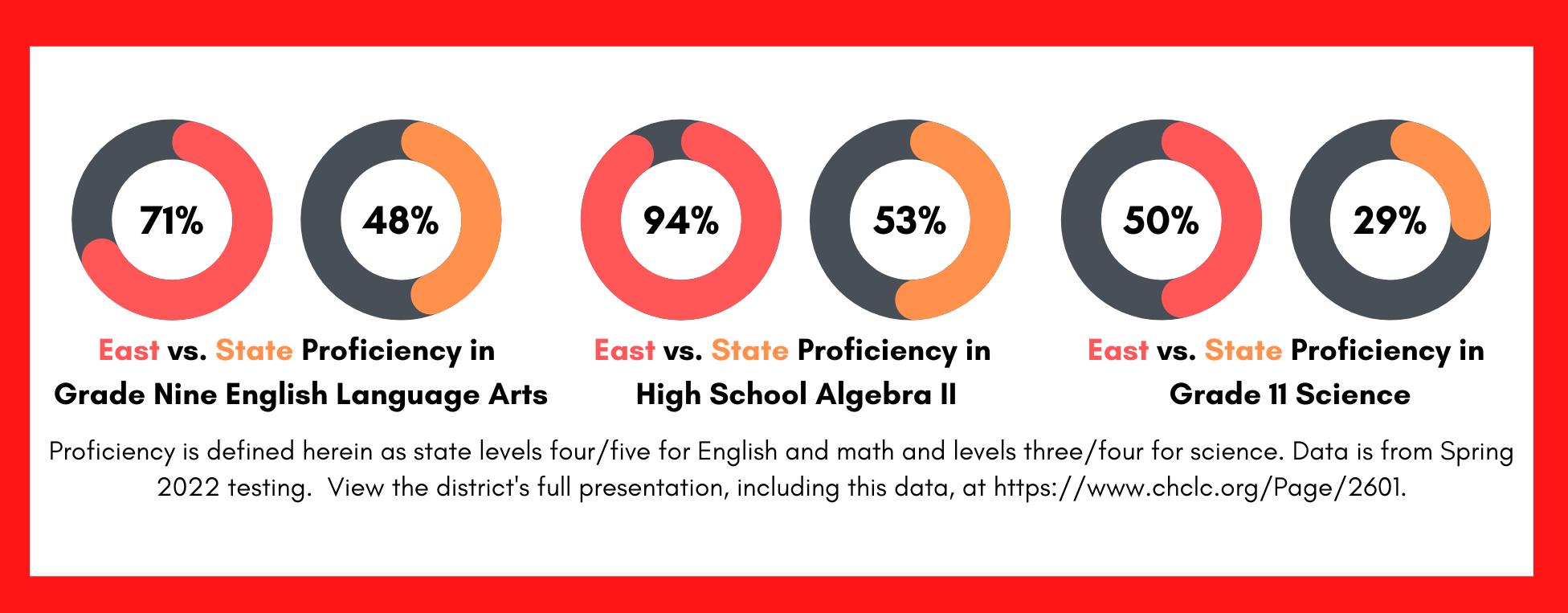
East Theater performed “The Canterville Ghost” as the fall play this year. The play took place on December 9, December 10, December 15 and December 16 at 7:30 p.m.

“The Canterville Ghost” follows an American family’s experience when they move into a haunted Eng-
ily, on their off nights.
“Typically, in East theater we have two casts: Red Cast and White Cast. Whoever is Sir Simon in Red Cast is Horace in White Cast and vice versa,” said Vingelli.
The cast began rehearsing in mid-October. It was crucial that the rehearsals ran according to schedule because they came at the same time as auditions for
guiding the actors. For “The Canterville Ghost,” Wang served as the stage manager. Vingelli and Maya Morad (‘24) served as the assistant stage managers. The three of them also helped to oversee the entire production.
Typically, Vingelli acts in the play, but this year she decided to step into the role of assistant stage manager, which focuses on behind-the-scenes.
“It’s really nice being able to work a lot closer in the tech aspect rather than being on stage,” Vingelli said.
The job of the stage manager is an important part of the production process and has many tasks. For example, Wang was responsible for creating the practice schedules and cast lists.
“I think the best way to describe it is that I was the overall communicator between the directors, cast and the crew,” Wang said.
lish manor. As they reside in the house, the manor’s ghosts pay them a visit.
“The main ghost is Sir Simon and he wreaks a lot of havoc within this American family, and they eventually try to get rid of him,” said Thespian Society president Carlotta Vingelli (‘23).
As for the cast, the female protagonist is Virginia, played by Miranda Rosenbaum (‘23) in the Red Cast and Madeline Reddy (‘23) in the White Cast. Sir Simon was played by Everett Garcia (‘24) in the Red Cast and Anthony Torrissi (‘23) in the White Cast. Garcia and Torrissi also switched off playing Horace, the father of the fam-
the spring musical in November.
The fall play and spring musical are chosen by the play directors. For the past several years, the directors have been East teacher Mr. Pete Gambino and Ms. Sandi Makofsky, who comes from outside of East.
“[Makofsky] is very experienced. She does shows in Voorhees. She works with plays and musicals throughout the summer. They typically choose [the play] at the end of the year and they choose it by themselves,” said stage manager Angelina Wang (‘23).
While Makofsky and Gambino directed the play, they are not the only ones
She was also responsible for “blocking” the show: writing down what each character does in each scene, writing notes on the scripts, writing rehearsal reports of all of the notes taken at a rehearsal and more.
During the actual performance, Wang and the other stage managers were the ones running the show. They informed the crew of when the lights and music go on. They also notified the cast when it was their turn to enter and exit the stage. Wang remained up in the balcony during the show and, via headset, told the assistant stage managers backstage to relay her messages.
For the design of the play, there was one set which depicted an English manor. Included in
that was a grand staircase, draped-brick walls, big windows, French doors, a mantle and more. Rather than making every prop, the Thespian Society borrowed pieces from other local theater departments.
“Something that I love about theater and performing is that you all help each other, every troupe helps each other. If we need a set piece that Voorhees has, Voorhees will give us a set piece. It’s very collaborative and makes it so much easier,” said Vingelli.
This year, practices were less intense for the fall play. Last year, practices occurred six days a week (including Saturdays, which were five-hour rehearsals). However, the actors in this year’s fall play were more experienced and the directors did not deem it necessary to hold more than two to three rehearsals per week.
“For this show, it’s just so lighthearted that the rehearsals to me don’t seem as tiring anymore. I feel like we have a lot of moments during the rehearsals where we can just laugh and have a lot of fun,” Wang said, remarking on her favorite part of the show.
■ By Aiden Rood (‘23) Eastside Editor-in-Chief
The start of a new year is always a busy time for the Cherry Hill Board of Education (BOE). In the past two months, highlights in Board business have included major election results and the passage of a dress code overhaul.
On November 8, 2022, Cherry Hill voters went to the polls for midterm elections that included battles for four seats on the local BOE. Ten candidates squared off for three standard, three-year terms, while two people went head-to-head for the remaining one-year term of a previous member who resigned. For the three regular seats on the BOE, the results were nothing unexpected: current BOE members Gina Winters and Joel Mayer retained their seats, while newcomer Adam Greenbaum won convincingly after campaigning alongside the current BOE members. In the race for a one-year term, however, challenger Kim Gallagher upset current BOE President Ben Ovadia. Gallagher was sworn in on January 3, 2023. She quickly made an impact by casting multiple “no” votes on Board business that was otherwise unanimously approved at the January 10th meeting of the Board.
This year the College Board announced that students enrolled in AP (Advanced Place ment) classes would have the option to take the AP exams digitally to earn college credit.
Since the AP pro gram started in the 1950s, mil lions of students have taken the exam with pen and paper.
At East, AP Computer Science Principles, AP Eng lish Language and Composition, AP English Literature and Composi tion, AP European History, AP Seminar, AP United States History (APUSH) and AP World History will be administered digitally this year.
“It seems to be the natural trend for the College Board and other standardized tests to gravitate towards digital testing,” said Mr. Darren Gammel, East’s AP coordinator. “Starting with seven AP tests this year will transition the school and [allow us] to ob-


serve the technical issues [East] might have.”
East administers 1,200 AP tests every year; This year, with the transi-
when many students could not attend in-person testing facilities. The College Board redesigned the testing format to allow students more flexibility and accommodation in disrupted learning environments and spotty connectivity.
The College Board announced “for the 2023 AP Exam administration, schools in the 48 contiguous states and Washington, D.C., can choose to give either paper or in-school digital exams (or a combination of paper and digital).”
digitally only using the AP Digital Portfolio for submission.”
The AP Digital Portfolio opened in November 2022 for AP Art and Design.
tion to a digital format, 300 of those tests will be digital. The digital AP tests are to be identical in terms of content. The College Board will still grade digital tests, but the platform and tools needed to excel digitally will be available to East’s teachers.
The decision came after the COVID-19 pandemic
Schools received an email in mid-August about the availability of in-school digital exams. “AP tests this year will be a lot less stressful because I personally hand write slower, so being able to type will be much easier for English and History students,’’ said Krisha Patel (‘25), a student taking APUSH 1 this year.
The AP Chinese and AP Japanese Exams will continue to be administered in schools on computers, but the College Board announced “starting this year, all 2-D, 3-D, and Drawing portfolios will be submitted
Digital exams might have minute differences in questions; for example, on an AP Calculus paper exam, students could draw out graphs to illustrate the concept, but on a digital exam, students will be shown a graph instead. Similarly, taking exams digitally in subjects like APUSH and AP Seminar will make the writing process of conceptual questions easier. Document-based questions and long essay questions may be less taxing on students than the previously administered handwritten tests.
However, experts said they would account for these discrepancies to ensure every AP test is “statistically equated for difficulty levels,” said Trevor Packer, Senior Vice President at the College Board who leads the AP program.
“Overall, I am really glad AP tests are online. It is far less stressful than a paper test,” said Barbara Armstrong (‘25), another student enrolled in APUSH 1.
Art by Bhoomi Kanojia (‘23)/ Eastside StaffMeanwhile, the BOE gave final approval in late November to a new dress code policy. The new policy, which has now taken effect, will establish more inclusive and less restrictive dress expectations for students throughout the district. Hats and hoods will no longer be banned unless they obscure facial features or sightlines. Shirts and dresses of all kinds will be allowed as long as they “have fabric in the front and on the side.” This will ensure students, often women and girls, will no longer be penalized for wearing popular garments such as crop tops and spaghetti straps. Additionally, the dress code now specifies that bra straps and waistbands need not be covered like other undergarments. While additional dress requirements may exist to maintain safety in certain environments, like science labs, the policy will generally apply to all students in all parts of the school; school staff may no longer individually choose to ban hats, restrict crop tops or otherwise enforce their own dress code; previously, staff had to follow the district dress code but were given latitude to enforce their own preferences even if school administrators did not do the same. The changes are intended to improve equity for students across the district.
Finally, the Board selected new leadership: Miriam Stern is the new Board President, while Joel Mayer is the new Board Vice President.
EASTSIDE
February 2023
On November 15 and 16, The Great Blood Drive Charlie Brown occurred in the East gym and annex. Students at Cherry Hill East were able to donate blood, but the blood drive was also open for people in the community.
Around 200 students donated to the blood drive this year which will impact the lives of the people receiving the blood. Just one pint of blood can save up to 3 lives.

This year’s blood drive theme was The Great Blood Drive Charlie Brown which is timely due to the fact the blood drive took place around Thanksgiving.
Participants received shirts with the image of Charlie Brown that read “You’re a good donor Charlie Brown.”
Other than receiving the
shirt, there was a variety of food catered for this event including Manhattan Bagel, Kibitz Room, Classic Cake and Chickfil-A.
People in the community were able to donate blood until 8 p.m.
“Blood Drive was very successful this year! We
had a great turnout and had such supportive teams of volunteers helping us out,” said chairperson So-
phie HeidtHeidt, along with the 10 other chairpeople, helped plan and promote the drive
as a whole.
The chairpeople organize the blood drive to be an experience that participants will enjoy as they help provide for the patients and set up for the drive.
They ask local restaurants for food donations for participants to enjoy. Overall, donating blood makes a significant impact on someone’s life.
Donating blood is so important because there are so many people out there who are in need of blood and helping save someone’s life with this opportunity is rewarding.
This organization is admirable and well known in the community and is always successful. This year’s fall blood drive was a huge success.
There will be another blood drive in the spring if you weren’t able to participate this fall.
Cherry Hill East is one of six high schools in New Jersey that is a Habitat for Humanity campus chapter.
East’s Habitat for Humanity trip to Baltimore, Maryland took place from November 10 to November 12. With 15 members of the club allowed to attend, members rushed to get their checks and permission slips in first.
Besides helping with the construction of a home, the students took part in a variety of activities such as visiting Fort McHenry and the National Aquarium and going on a private boat tour.
Habitat for Humanity is a nonprofit organization with the mission of building homes for families in need of decent and affordable housing. Spreading across all fifty states and seventy countries, the organization draws in volunteers of all ages and backgrounds. Habitat for Humanity aims to bring people together to build homes where struggling families can grow.
They stress the link between stable households and their benefit to child development.
“Once the homeowner buys their house, they’re paying the mortgage back to habitat. That’s like a revolving fund that goes back to Habitat that helps build houses faster and more efficiently,” said Cherry Hill East’s Habitat for Humanity Advisor Mr. Frank Console.
East’s campus chapter was formed by Console when he started working at East after his previous job as a construction supervisor for Habitat in West Philadelphia.
Since then, the club at East has grown in popularity, having two trips a year, one in the fall and one in
the spring. Like the majority of fall trips in the past, the students visited Baltimore.
“We’ve done Baltimore about 16 times. I chose Baltimore because I knew it was the largest urban affiliate in the United States. It has the most houses, about 800 houses, completed. I thought it was a culturally interesting city to visit,” said Console.
On Thursday, November 10, the field trip participants and two teacher chaperones, Console and Mr. Christopher Caskey, left Cherry Hill East at 8 a.m, and arrived at Lovely Lane Church around 10:30 a.m.
The field trip participants stayed at Lovely Lane Methodist Church. Equipped with a full kitchen, basketball court, and over six bathrooms, the students felt comfortable and well provided for.
“Lovely Lane hosts many groups that do community service, not just Habitat groups. It’s [the church’s] way of building community in Baltimore,” said Console.
Taking the same school bus to all needed destinations, the students were provided with convenient
on the Patapsco River, and were allowed to eat at any restaurant of their choice.
transportation. They were taken to Fellas Point, a neighborhood in Baltimore
After, they toured Fort Henry, which defended the Baltimore Harbor during the War of 1812. A water taxi picked the students up from the fort and took them to the National Aquarium on the Patapsco River. Having plenty of time to spend at the aquarium, the students engaged in a variety of activities including touching jellyfish and stingrays, watching dolphins play, and taking pictures.
After the aquarium, the students walked around
the Inner Harbor before returning back to Lovely Lane Church and making Mr. Console’s “Habitat Pas-
lation into the ceiling, putting in support planks into the basement ceiling, and hammering nails into the
ta” for dinner.
“Habitat Pasta” is a tradition Console started over his years leading East’s Habitat for Humanity — a meal he makes sure is made on every field trip.
“I wanted to have things that were easy to make and that would appeal to different dietary needs. We have the pasta with meat, the one with chicken, and the vegetarian one,” said Console.
Friday, November 11th, was dedicated to working at the Habitat. The students arrived at the site at 8 a.m. and worked until 2:30 p.m.
They were greeted by the volunteer coordinator who organized the trip, the construction supervisor and a site supervisor who all work for Habitat for Humanity and direct volunteers.
With the exterior and basic framework completed, the students worked inside with the help of the construction supervisor and site supervisor.
They had a variety of jobs including putting insu-
floorboards. Stressing safety, students were encouraged to wear both safety glasses and masks.
Although the work was strenuous, the students enjoyed their time and had the unique opportunity to have hands-on experience with construction work, many said.
Exhausted after the day of work, many students took naps and relaxed before reconvening at 7:30 p.m. for pizza and duckpin bowling — a bowling variation with smaller balls, popular in Baltimore—at 9 p.m. They returned home the following morning at 11 a.m.
During the three-day trip, students were able to visit some of Baltimore’s most popular tourist sites, learn about the Habitat for Humanity organization and volunteer their time to help build a much needed home for a struggling family.

The memories from the trip and the community impact will last a lifetime.
 (‘23).
(‘23).
Students use their voices every day — to ask questions and to answer them, to communicate ideas, to express emotions. But on a deeper, more collective level, student voice is a powerful agent for change within the community at large.
“Student voice in its purest sense would enable every student in this school to feel the agency and have an avenue for sharing their thoughts on how they can improve their experience at school,” said Cherry Hill High School East Principal Dr. Dennis Perry.
According to Perry, the ultimate goal of student voice is to foster a productive learning environment between students and staff. Four years ago, East teachers were provided training from the Quaglia Institute — an organization dedicated to improving the safety of educational communities.
Currently, one teacher representative from each department works in East’s Professional Learning Community (PLC), meeting frequently with students to understand their perspectives more closely.
Perry hopes these efforts will make East a more comfortable place for everyone. In the past, there was not always a direct way for students to make their voices heard.
“My first year here at this school, there was an attempt by students to do a sit-in,” Perry said. “Essentially, it was just a few students who were stoking the passions of others.”
To avoid disruption and unease, Perry hopes that all students have a means to vocalize their opinions, whether it be through their peers in leadership roles, or directly through their grade level administrators.
The Center for American Progress, a public policy research and advocacy organization, outlines various implementations of student voice, including student surveys, student government, student journalism, student-led conferences, student involvement in governing bodies and youth activism.
This article seeks to explore these student voice strategies by examining how they are implemented at East.
Student Surveys
Surveys serve as one of the most simple yet effective ways to collect student perspectives. Student surveys, typically conducted online, are beneficial because they typically encapsulate data from the entire student population and can be used to set goals and measure growth over time.
On the flip side, however, surveys are a rather passive method for measuring student voice, as they do not allow students to take initiative and lead action on the changes they would like to see.
The school and district administration have used surveys to gauge student preferences. For example, when selecting new courses to add to the curriculum, a committee of teachers from both East and West considered data from a student survey regarding courses students would like to take, as well as teachers’ suggestions.
It must be noted, however, that no matter the results of any given survey, it does not always lead to direct change.
A familiar avenue of student voice is the student government. This body has influenced the East administration’s decisions in a variety of ways.
Within the past two years, one issue that SGA
(Student Government Association) has helped to address was bathroom quality.
At first, many bathrooms remained locked due to increased vandalism and destruction of property.
The Student Voice Committee, a subsection of SGA dedicated to uplifting student voice, raised concerns about this solution. They expressed the challenge of finding an unlocked bathroom within a reasonable distance of their classes.
With this feedback in mind, the current system of signing in and out of the bathroom, whilst leaving the C-Wing bathrooms open during lunch, was implemented.
“Not that it’s the best plan in the world,” said Perry, “but the catalyst for making a change was student voice in our school.”
There is still controversy surrounding the current bathroom policy. While it’s impossible to meet the desires of every student at East, administration seeks to find a balance amongst the varying opinions held by East students and staff.
Last year, one concern of the student body involved the treatment of girls’ athletics. Student representatives vocalized the lack of support toward girls’ sports teams and its negative impact on the culture at East. Now, Perry has set a new expectation for teachers to attend girls’ games.
“You should see — and have seen — an increase in female sporting events having attendance by teachers,” he said. “Hopefully then, more students as well.”
Additionally, by listening to leaders from various culture clubs at East, Perry is able to understand the diverse desires of the student body. Change cannot be implemented without considering all perspectives,
including variations in age, academic proficiency and personal identity.
Perry regularly meets with these representatives and urges students to schedule a meeting with him should they feel compelled. Grade level administrators are another contact of which students can take advantage.
Another method through which students make their voices heard is involvement in governing bodies — particularly through the Board of Education (BOE).
Similarly to many school districts nationwide, the board involves students through two student representatives, one from each high school, as well as two student representative alternates. BOE representatives advocate for students’ needs at board meetings and provide a way for students to stay updated on the board’s discussions and projects.
However, students don’t need to be a representative in order to address the board. Organizations such as Students for Later Start Times, and even impassioned indviduals not affiliated with an advocacy group, are able to speak at the district’s meetings.

Students can also turn to East BOE Representative Aiden Rood (‘23), or alternate Vivian Rong (‘23), with any questions or concerns.
Last year, in response to forced teacher transfers by the district, student leaders organized a walk-out. On April 29, 2022, hundreds of students left class to meet
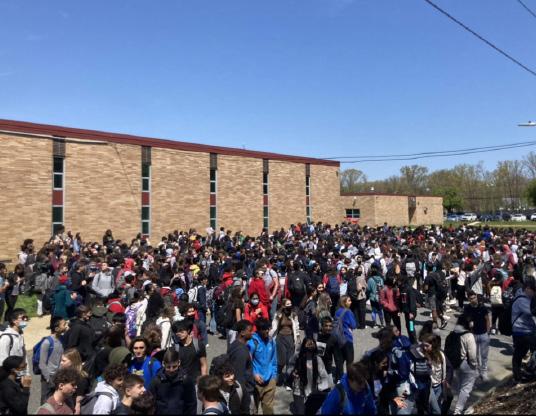
on the turf field. Students gave speeches, spoke to the press, designed signs and shouted chants.
“I think this was probably the most successful protest that I’ve ever seen,” said Student Body Vice President Crystal Yeh (‘24). “Everyone was out there… That just shows that student voice was important for everyone.”
Others spoke to the Board of Education directly at their meeting just three days prior.
“I think I can speak for everyone when I say that [East] feels like a family, and it’s solely because of the teachers and their enthusiasm, passion and support,” said Emily Pober (‘23).
While most of these teachers were ultimately transferred, the passion from their students was undeniably demonstrated.
In January of 2022, Eastside published a double-truck titled “Not So Welcome?”. In this story, 64.8% of LGBTQ+ students reported a homophobic environment at school, and 58% of Black and Latino students said that there’s a racist environment at East. In addition to these unsettling numbers, 70.6% of students said they have a trusted adult they can turn to.
In response, administration dedicated class time to a variety of lessons, addressing topics such as microaggressions, how to be an up-stander and ways to find community at East.
While there can’t always be perfect solutions to complex problems, students have many avenues through which their voices can be heard, making “student voice” a reality.
“It takes a special person to be a teacher in today’s world.”
Those words from Ms. Gabriella Sanzari, a math teacher at Cherry Hill High School East, sum up the complex nature of the teaching profession today. Sanzari, along with Ms. Jaclyn Pitt, is one of the two relatively new East teachers who American High School, an Eastside series, will follow throughout the year. The two women both entered the teaching profession four years ago and joined East’s staff two years ago, enabling them to provide fresh pedagogical perspectives.
Speaking of fresh perspectives: COVID-19. Phones. Politics. Socioeconomics. Disabilities. Much, much more. All of these challenging factors are playing new, evolving and major roles in education right now. For teachers more than anyone, that reality can present both challenges and opportunities, shaping the American education system for better or for worse.
Sanzari elaborated on what “special person” teaching requires by saying that people should only go into the profession if it is their true passion. For her and other passionate teachers, the rewards and fulfillment of their work outweigh its intense challenges. For others, the draining requirements may be too large of drawbacks.
“If you’re going into this profession to get summers off, maybe rethink that,” Sanzari said.
For better or for worse, many would-be educators have heeded that advice over the past several years. Whether it has been due to potential teachers deciding not to pursue the challenging career, or former educators leaving the field of teaching, the availability of K-12 educators has sharply declined. According to the Bureau of Labor Statistics, 300,000 teachers have left their field since 2020. Even before the COVID-19 pandemic hit, more teachers were needed in U.S.

schools. Now, full-blown teacher shortages are raging across the country.
On November 10, 2022, New Jersey Governor Phil Murphy announced the creation of a Task Force on Public School Staff Shortages in New Jersey. The announcement came as situations like that of Eastside High School in Paterson, New Jersey, played out across the state; there, over 600 students have no permanent science teachers, forcing them to complete asynchronous assignments in the school auditorium, as the national publication Time recently reported. In nearby Pennsylvania, the past decade has brought a 64% decline in the certification of new teachers. Today, instead of regular certifications, more Pennsylvania teachers are receiving emergency certifications, which do not require full qualifications. And right here at East, students are regularly sent to the cafeterias for class when there are not enough substitute teachers available to supervise in the classroom.
So, amidst a nationwide struggle to bring qualified, willing educators into K-12 schools, why have people like Pitt and Sanzari been going against the trend and entering the teaching field during such difficult times?
For Pitt, the challenges that have led to a national teacher shortage are no match for the many positive experiences she has in her job.
“I think everyone should be a teacher,” Pitt said, later adding, “I see myself as a lifelong teacher… the opportunities are endless.”
Pitt said that the most rewarding part of her job is seeing students succeed: she described hearing from students who said they previously hated social studies but loved it after taking her class.
Meanwhile, Sanzari has had similar experiences in a different area of study: mathematics. There, she described finding fulfillment in facilitating and witnessing students’ growth.
“It really is amazing to see how quickly and how well students are able to learn content that seemed so difficult to them at first…
that’s one of the most rewarding parts [of teaching],” said Sanzari.
Pitt and Sanzari’s passion for fostering students’ learning and growth shines through. In their classrooms, the two teachers help students think critically and master complex concepts; the fulfillment from doing so drives their commitment to their profession.
Despite the rewards some teachers experience today, their work may only increase in difficulty as time goes on. With each passing year, new challenges emerge in K-12 education. Even without external complications, facilitating education around complicated topics can already be difficult. Today, challenges have multiplied with the proliferation of technology and the impact of COVID-19 eroding fundamental elements of the education system such as respect and engagement with teachers.
“Making sure that there’s a level of respect in the classroom, I think that’s the difficult thing to manage as a teacher,” Sanzari said, adding that constant distractions from phones and other sources have made classroom management more difficult.
With kids constantly drawn to their phones, teachers must compete for students’ attention. Remote learning during the COVID-19 pandemic did not help matters, as students became only more connected to their devices.
“It’s really hard to effectively keep students com-
pletely away from technology because it is something that they’re so used to,” Sanzari said.
However, both Sanzari and Pitt have found ways to adapt, bringing technology into the fold by using Google Classroom, digital games and other online learning tools; this has allowed students to use their devices more productively.

Pitt said that remote learning disengaged many students from learning, making finding ways to reengage students a priority.
“After [the pandemic], what is the traditional classroom? How does it look?” Pitt asked, speaking to the changing dynamics of education in the face of post-pandemic challenges.
While adopting new, technologically advanced teaching methods may be helping students succeed in today’s schools, some teachers have been left behind as they struggle to adapt to these new practices. Using online learning may come naturally for recent newcomers like Pitt and Sanzari, but this is not always the case.
Sanzari said she believes that the impacts of technology and COVID-19 drove some teachers to leave the profession.
“I, in my own experience, have seen teachers that really excelled and really loved it, and then when COVID came around, they had to kind of reevaluate what teaching looks like… There were a lot of teachers who struggled,” she said.
In sharing why they became teachers during such
challenging times, Pitt and Sanzari made it clear that there is a compelling case for people to continue pursuing teaching. However, they also noted the challenges that are deterring potential teachers from entering the workforce. In the stories of Sanzari and Pitt, hope remains for the future of education in the United States. Both teachers said they feel supported in their jobs, comfortable in their lives and happy to be impacting the lives of students through their work. If every prospective educator saw things the same way, it seems unlikely that teacher shortages would remain.
However, not everyone sees the profession in that same way. For some, the pay is not enough, the day-to-day challenges are too much to outweigh the potential fulfillment, and teaching no longer appears to be the attractive career option it once was.
Some states are raising teacher salaries, while others are breaking down barriers to enter the profession. In New Jersey, leaders recently agreed to remove a difficult testing requirement that was previously part of the certification process.
Still, schools across New Jersey and the nation lack the teachers they need. Will up-and-coming educators who are out to make an impact resolve the staffing crises, as people like Pitt and Sanzari have recently helped do, or will such crises only get worse in the years to come? Right now, no one seems to know the answers, leaving our nation’s next generation of children with an uncertain future.

South Jersey has its fair share of bakeries that specialize in cakes, cookies and more. However, “do-nut” forget about the wide range of unique confectioneries that sell delicious doughnuts throughout the region. Given the task to rank the best doughnuts in South Jersey, it was important for me to consider all of the elements that factor into the “perfect” doughnut — consistency, taste, appearance and the atmosphere of the shop itself. After considering these criteria, I came to the conclusion that Mochinut, McMillan’s Bakery, Springdale Farm Market, Duck Donuts, and Gallo’s Bakery make up the top five best doughnut shops in South Jersey. A further dive into each bakery is necessary in order to justify my reasoning.

1st Place: Mochinut


Creative concept with poor execution. This just about sums up Duck Donuts. Located in Marlton, Duck Donuts is known for their custom doughnuts. The shop itself is bright and inviting, and they have an easy website to navigate in order to place online orders. The shop offers both custom doughnuts and “fan favorite” doughnuts which are helpful for those looking for a pre-set doughnut combination. For my Duck Doughnuts experience, I purchased a vanilla oreo doughnut, a chocolate oreo doughnut, a chocolate strawberry doughnut, a mint chocolate doughnut, a lemon coconut doughnut, and a vanilla confetti doughnut. It’s safe to say that while the presentation of the doughnuts is rather average, the toppings are what bring the flavor. Additionally, the doughnuts were presented in a rather careless fashion which took away from their initial appeal.

101 NJ-73, Marlton, NJ 08053
Picture the perfect doughnut. That’s exactly what you receive at McMillan’s Bakery. Although the store is not visually appealing, their incredible products help seal the deal. The shop sells a variety of baked goods; however, they are known for their outstanding doughnuts.


I purchased a chocolate frosted doughnut, a vanilla frosted doughnut, and their renowned cream doughnut. While the trio was rather unappealing to the eye, it tasted like perfection.


The chocolate and vanilla doughnuts had an ideal fluffy consistency with an exquisite frosting. These fulfilled my perception of a model, classic doughnut. Exceeding my expectations even further, the cream doughnut was on an entirely different level. Decadent homemade whipped cream was sandwiched between two powdered doughnut slices, creating a delicious doughnut ratio. McMillan’s is surely the place to go if one is looking for a classic, quality doughnut.
15 Haddon Ave, Haddon Township, NJ 08108
When you combine the classic American doughnut with the Japanese mochi dessert, your result is the mochi doughnut. Mochinut takes a unique spin on the doughnut through this combination. The store makes their doughnuts out of rice flour, and each doughnut is connected in a circle of eight dough balls. Each doughnut is elaborately decorated, and they are extremely easy to share due to their structure. The store itself is inviting and offers a wide variety of flavored doughnuts. I purchased the churro, matcha and Vietnamese coffee doughnuts, and each was, in a simple term, perfect. Each doughnut is presented neatly and is addictively delicious. After consuming one doughnut ball, one is left with the urge to go back for another. Mochinut sells a product that is unlike any other doughnut shop with their combination of mochi and doughnuts.
871 Cooper Landing Rd, Cherry Hill, NJ 08002, USA
3rd Place: Springdale Farm Market

Amongst the produce and organic produce, one can find a hidden gem at Springdale Farm Market. Springdale’s apple cider doughnuts are a staple to regulars at the market, but their presence in South Jersey is not as well-known as the doughnuts that are from specialized bakeries. However, the apple cider doughnuts are truly an exciting treat. Coated in sugar, the doughnuts have a cake-like consistency which is super moist and seems to melt in one’s mouth. It seems as though the one aspect that Springdale Farms fails in is the fact that they only offer one type of doughnut — creating a rather limited menu. Yet, perhaps this adds to the special effect of the apple cider doughnut, leaving you wanting more.
1638 South, Springdale Rd, Cherry Hill, NJ 08003
5th Place: Gallo's Bakery

Gallo’s Bakery offers a multitude of delicious treats, including a wide assortment of doughnuts to choose from. I purchased a vanilla glazed chocolate doughnut, a powdered vanilla doughnut, and a jelly doughnut. Although the bakery serves its purpose of producing classic doughnuts, the treats are mediocre at best. In regards to the chocolate and powdered doughnuts, the consistency was too cake-like for my preference. Additionally, they were both rather dry, so frosting was definitely needed to balance out this flaw. The jelly doughnut was the redeeming factor of the order as it had great consistency and was very flavorful. Although the doughnuts were not necessarily “perfect,” Gallo’s still meets most of the criteria for an adequate doughnut.
36 NJ-70, Marlton, NJ 08053
 ■ By Alena Zhang (‘23) Eastside Editor-in-Chief
■ By Alena Zhang (‘23) Eastside Editor-in-Chief
Located in Germantown, Philadelphia, Whosoever Gospel Mission is a Christian nonprofit organization that supports homeless or needy men.
rehabilitation and education for long-term impact.
Whosoever Gospel Mission has been dedicated to providing long-term residential programs that foster growth and future career developments since its opening in 1892.
I first discovered the organization from my time at Project Brother Love (PBL), a summer residential ser-
After entering the Whosoever Gospel Mission building, my preconceived notions of what volunteering encompassed changed. Yes, volunteering includes providing immediate shelter, safety and food, but it can also extend to impacting individuals longterm.
ticipants attend workshops, seminars, job readiness training and individual and group counseling, among other opportunities intended for gaining educational and vocational skills.
When I first arrived, I wasn’t sure what to expect.
enter the second phase, Careers. During Careers, participants receive off-site training and gain career experience as they seek permanent employment.
Beyond providing housing assistance, the organization also offers opportunities for counseling,
■ By Ellie Noh (‘24) Eastside Community Editor
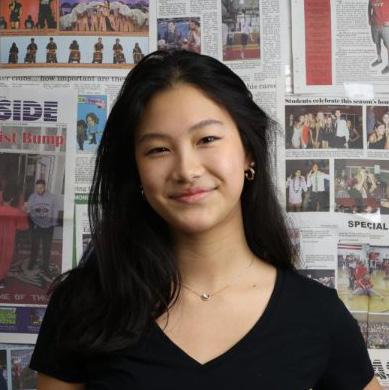
With the holiday season, it is important to carry out kindness — the gift that keeps on giving. Recognizing issues faced by struggling families, Karen Wislocky (‘00) has continuously found ways to make an impact in the community, one kind act at a time.

Wislocky first started by continuing the “Food is Free” project in the Camden County area, created by John VanDeusen Edwards in Texas. She was able to provide for families who were struggling to put food on the table by growing vegetables in her own backyard.
Wislocky said, “Having compassion everywhere is important. People struggling [are] just as common as people thriving… there [are] people in need pretty much everywhere we look.”
After the “Food is Free” project, Wislocky wanted to continue her imprint in the community and ended up forming her own project called “Holiday Helpers”. In this project, she organizes gift-wrapping and gift-giving for families that need help during the holiday season. She first
vice camp that serves different organizations and ministries for the Philadelphia community.
sets up an application to be filled out with specific details, including age and
With the organization’s New Life Program for Men, a three-phase plan that aims to prepare participants for career opportunities through offsite vocational training and independent living, there is a strong emphasis on supporting and empowering individuals in pursuing their future aspirations. This summer, I once again volunteered at Whosoever Gospel Mission for the Career Track Learning Program, part of their first phase for the New Life Program. In this first phase, par-
donations of the items that are listed by the families, which are then dropped off
“Each tutoring session was a chance to connect with an individual and understand their past experiences, their challenges and their aspirations.”
But, my worries soon faded. As I helped the men practice vocabulary exercises, job interviews and upcoming HiSET exams, we had the opportunity to share stories and have meaningful conversations.
Each tutoring session was a chance to connect with an individual and understand their past experiences, their challenges and their aspirations.
After students complete the first phase of the New Life Program, they
“You can’t do it all by yourself even if you
Whosoever Gospel Mission also has two thrift stores to provide financial support and workforce development training for the residents.
During my time with PBL, I helped out at their thrift shop, one of two locations at the Germantown Thrift Shop and Lighthouse Thrift Shop. While organizing different categories of clothing, I worked alongside some of the men living in the facilities, listening to their stories of loss, recovery and hope.
In the third phase of the New Life Program, participants move into their own independent living arrangements, all while continuing to receive support and services from Whosoever Gospel Mission.
Throughout individuals’ time at Whosoever Gospel Mission, there is a thriving community ready to help and support them in pursuing their future aspirations — one phase at a time.
You can find more opportunities to volunteer with this program at https:// www.whosoevergospel.org/ wp/.
what they would like to receive such as clothing, toys and kitchen items.
“The important thing to me is the needs and the wants, because we don’t want to just get them socks and underwear and a new coat. We want to make sure we have the things that they’re looking forward to,” said Wislocky.
She then spreads the word to people in various communities primarily through Facebook to collect
to her house. In the past, Wislocky has received donations from hundreds of people. This year, she received around 550 items for 15 of the families that filled out the applications. These gifts are then organized by families and distributed to volunteers who wrap each gift. Other ways to volunteer include sorting and collecting donations, writing “Letters from Santa” and helping with the gift dropoffs to families.
you had support behind you in some shape or form…the people who volunteer are amazing,” said Wislocky.
Last year, after hearing my sister buying multiple rolls of wrapping paper, I couldn’t help but be curious about what she was doing to spread holiday joy. Imagining the smiles on the families’ faces, especially the children as they open up their new toy, I was eager to help wrap the gifts

one by one. Even though I may not meet the families, it is signif- icant for me to remember the impact we had made in their lives, even if it may just be folding and taping wrapping paper.
“We’ve also had families that graduate out of the program that don’t need help anymore… they donate one or two things themselves,” Wislocky said. “It’s really this delicate balance of life… we need to really appreciate what we have when we have it.”
“Holiday Helpers” aids with gift giving throughout the community
Throughout the community, various organizations for which students volunteer have had a large impact on the students and those around them. Alena and Ellie talk about how the organizations they volunteer for aid in giving back to people in need.
- Alena Zhang (‘23)Ellie Noh (‘24)/ Eastside Community Editor

 ■ By Gia Gupta (‘24) and Ellie Noh (‘24) Eastside Community Editors
■ By Gia Gupta (‘24) and Ellie Noh (‘24) Eastside Community Editors


Ice Rink, Rothman Orthopaedics Cabin and the Made in Philadelphia Holiday Market.


In the heart of Center City, a quaint winter haven of ice skating, lights and festive decorations emerges every year: Dilworth Park.


We visited Dilworth Park on a chilly afternoon, amongst the local passers-by of Philadelphia and other visitors.
Nestled in the center of the park is the Rothman Orthopaedics Ice Rink (open from November 4, 2022 to February 26, 2023). Visitors can purchase tickets online for 90-minute skating sessions at the rink. There are also rental skates available and lockers for holding belongings at the site. Under stringed lights and surrounded by the Philadelphia City Hall Gates and Made in Philadelphia Holiday Market, the rink is in the perfect location for a memorable and photogenic experience.
Department Philly. As we strolled past the ice rink and market, we were met with an enchanting garden with plants of all shades — yellows, greens, reds and purples, and surprising flapping birds hidden under benches and flying around our feet. Wintergarden (open from November 1, 2022 to March 26, 2023) is home to hundreds of diverse plants, unique topiaries, lighted photo opportunities and benches to get lost in a win ter ambience. It’s almost as if a small refuge, but just large enough, of twinkling foliage was given to the concrete landscape that encompasses most of Phila
lights, a homey ambiance reminiscent of warm ski cabins emanated— a place to enjoy delicious food amidst a blend of unique conversations and stories. We walked from the indoor seating area to the outdoor seating area riddled with fireplaces modeled like campfires. We warmed ourselves around the fireplace sitting on wooden stumps— an intimate and cozy place to converse with
accompanied it did not help in any way. As soon as we took the first bites of the Cabin Burger, the meat seemed slightly too salty at first, but it balances with the sweetness of the red cabbage and the flavors just flow together. Overall, the food was delicious and there were drinks available like hot chocolate for the cold weather.
Walking back outside,
Throughout the park, there was ambi ent pop and indie music, and as we walked to the close Philadelphia City Hall Gates, we saw a flutist playing beautiful music in the charming area. The park was wreathed and lit with sparkling lights, creating a refuge of calm beauty amidst a bustling cityscape.
Throughout Dilworth Park, main attractions include Wintergarden, Rothman Orthopaedics

In the surrounding local Made in Philadelphia Holiday Mar ket (open from November 19, 2022 to January 1, 2023), ven dors at different booths sell a range of items like jew elry and skincare products— a perfect opportunity for shoppers to support local businesses while shopping.

“The market has been happening for seven years and we’ve been a part of it, and every year it just gets better and better. You can get all of your holiday shopping done, and [there are] drinks and [a] skating rink. It’s a really good time for the family and a nice night out,” said Morgan Jamison, owner of booth 21, Crafts
delphia. It’s small enough to say that it would be very difficult to get lost, but picturesque enough that if you get lost in the beauty, we wouldn’t blame you. Trying to seek cover from the crisp weather, we breathed a sigh of relief as we were met with the heaters that provide a toasty warmth in the Rothman Orthopaedics Cabin (open from November 4, 2022 to February 26, 2023). With the dimmed
ski resort after a long day of activi ties, this cabin can serve as a rest space for you to rejuvenate as you finish skating at the Rothman Orthopae dics Ice Rink.
To add to the Cabin, the one thing that is most important to us is… the food. We ordered the Cabin burger, waffle fries, and hot dog. The hot dog did not have a considerable wow-factor but still was enjoyable. Almost as if it was harmonious with the upcoming seasonal activities, the waffle fries were definitely strongly seasoned and the cheese sauce that
warm glow. As the night came to a close, the weather grew colder, the lights grew warmer, and the environment grew more crowded. As the night came to a close, we drifted away from the sparkling lights, an evening of warmth, fun, beauty and winter comfort. With a final glance at the place that now holds unforgettable memories, we write this story to to introduce the rest of the community to the beauty of Dilworth Park.
At MFC Authentics & Framing, we understand that our clients have specific framing and decorative needs Our goal is to work with you to offer convenient and affordable products & services.
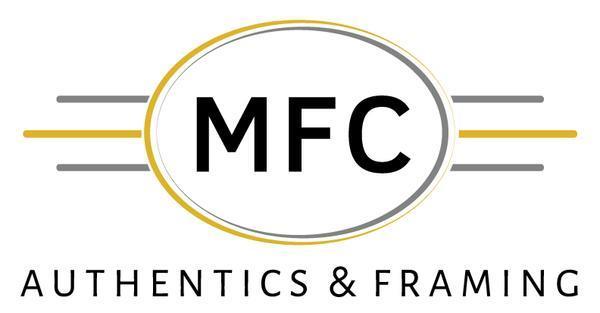
Our vast selection of frames & matboards will allow for each of our clients to properly portray their individualized image, design & style for their home & office wall décor.


We specialize in artwork, family photos, diplomas, canvas stretching, jersey framing & more!


All custom framing is done in house, rush orders are never a problem!

East students often struggle with getting through the classic books that are assigned to them in English class. Some of these books are “Romeo and Juliet,” “To Kill a Mockingbird,” “The Count of Monte Cristo,” “The Great Gatsby” and “Hamlet.”
Classics can be defined as excellent works of literature that receive immense praise from the public for their masterful and impactful lessons and last the test of time. As it is, many of these books are old, some even hundreds of years old, and as a result, many students have a strong aversion towards them. They’re too boring, too weird, too hard to understand or too irrelevant to their lives, so instead of fully reading these books, students resort to using websites such as SparkNotes, CliffNotes or Shmoop to understand their surface messages and plot and keep up in class.
A common complaint students have is that English class books are outdated; however, if one allocated the necessary time to read and examine these books, they could realize that although the context of one’s problem may change, humans often face similar struggles no matter where
and when a story takes place. It may take effort to discover and apply them, but the moral lessons that classic English books teach can not be understated.
Sure, many know it is not the best idea to push through life at full speed, but William Shakespeare burns the deadliness of hastiness into every one of his reader’s minds, when despite their earnest intentions to love each other, young Romeo and Juliet end up dead. Shakespeare makes a striking statement through this heartbreaking ending that is all too relevant for teens who often hope to fast forward through their youth but don’t recognize the responsibility that comes with adulthood and the heavy weight of one’s decision making when no person is there to catch you when you fall.
Ilanna Bernstein (’25) believes “Odyssey” by Homer and “Great Expectations” by Charles Dickens, two ninth grade required reading books, are books that gave her great wisdom.
“Even if they are boring… they teach important lessons like how people should stay humble,” said Bernstein.
Some students may find it more enjoyable to read modern books that directly relate to their life, but
there is only so much you can learn when you are in a state of comfort, where there is no prodding of the mind to ask why, how and what?
The AP English Language and Composition as well as the AP English Literature and Composition exams that many students take at the end of their junior and senior years require students to apply comprehensive and critical thinking to readings, including many of the classics read in class. Being able to understand difficult text is crucial to a student’s performance on these important tests.
Sophomore English teacher Ms. Jodi Morley also notes how the required English books students read don’t have to be seen with the viewpoint that they are so far removed from today’s society.
“Most of these books are about shared human experiences that transcend time and place. The language might be unfamiliar to us, but we know these people with their trials and tribulations and their attempts to find the answers to life’s big questions… [There is] something to be said about something that lasts so long and is still being chosen to [be] read,” said Morley.
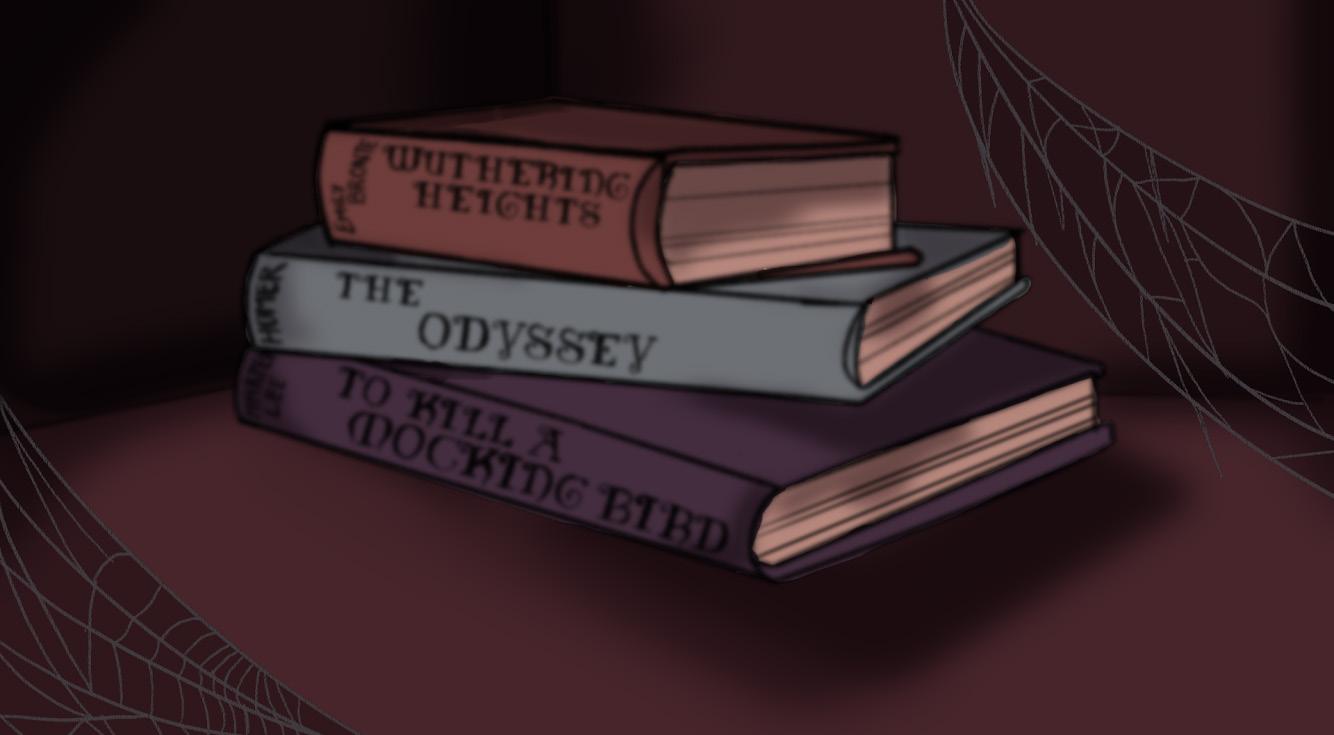
The classics, whether they be books, movies or songs, are special parts of the history of humans. They show the lens people once saw the world through. Just because something at face value may seem boring or irrelevant does not mean that they have nothing of practicality to offer. Students gain immensely when they are given books and are able to find out for themselves why they have had such longevity and hold in culture. Of course, reading classics can be difficult, but as the saying goes, nothing worth having comes easy — and that includes timeless knowledge.
Being a student at East is an economic proposition – a family needs to be highly financially stable for their child to be “involved.” Far removed from the idea of public school, where everything is supposed to be free, activities and additional enrichments are only reserved for the financially stable at East.
Public schools op erated by school dis tricts, free to attend, open to all stu dents, and funded by federal, state and local govern ment should make extracurriculars accessible to ev eryone. The aware ness and accessi bility to financial help at East is very low — in fact, it is practically nonexis tent.
For example, to partici pate in Model United Na tions (Model UN), there is a delegation fee of $10 for every conference. While it seems a minuscule amount now, to truly succeed in Model UN, the participant should be consistent. So, that one fee could become $50 ($10 for every conference attended).

Similarly, for clubs like Health Occupations Students of America (HOSA), the joining fee is $64; for Distributive Education Clubs of America (DECA), it is $20; for robotics, trips cost $30; for sports, there is an $80 joining fee.
While these seem to be
small amounts individually, when combined, the monetary expenditure families pay for their child to be “involved” is substantial.
The lack of awareness surrounding financial aid is missing in East’s ethos, resulting in a hierarchical and divided student body. The activities office should improve access to financial assistance — the lack of awareness over seeking financial support perpetuates the idea that it is shameful to seek financial help.
By excluding students that need financial support, students may feel like East is categorizing them as the “other.”
Not only does widespread inaccessibility to financial support exist at East, but clubs barely do anything to offer financial
support.
It is imperative for clubs to point students toward financial help touch points and for East administration to provide some form of financial aid for students.
In addition, course selection at East is a financial monopoly. Financially stable students spend extraordinary amounts of money on a third-party source (Founders Education) to obtain the appropriate credits for the school year. These students have more freedom to learn and study what they wish.

While this is not a problem, it simply reinforces that financially stable students are more involved and have their needs better met by East.
With colleges expecting more robust students, extracurriculars play an imperative role when enhancing a student’s application.
Therefore, it is essential that East must make every opportunity accessible to everyone. Students should have the liberty to choose, participate and mull over interests without having to shoulder the burden of the financial cost.
After all, high school is a time of exploration, and learning institutions should only help foster that passion - not inhibit it.
When it comes to academic rigor at Cherry Hill High School East, nearly all students can relate to the competition faced daily. Constant stress over upcoming deadlines, joy over high marks and comparisons of test grades can be heard throughout the school’s hallways on a daily basis, no doubt due to this extreme level of competition.
However, in recent years, a new trend has risen. Currently, there is an ongoing inflation in the grades of students at East. This inflation is due to a plethora of different reasons, ranging from COVID-19 to advancements in East’s overall grading system. Regardless, this movement has led to inflated
Grade Point Averages (GPAs) and class ranks over the past few years.
With so many students having inflated grades, GPAs and class ranks, what could go wrong?

Many students may look at this recent inflation and feel gratitude, without realizing the potential detriments to the overall student body at East.
In the Class of 2013, 105 kids retained a GPA of 6.0 or higher. Fast forward to a decade later, and the Class of 2023 contains 208 kids who maintain a GPA of 6.0 or higher. With the number of students retaining a GPA of at least 6.0, East’s class rankings are skewed to an extreme.
East Principal Dr. Dennis Perry explained that the recent inflation in GPA has been directly related to COVID-19. With classes shortened and a modified grading system implemented, students were given lots of grace.
Because of these practices’ effects on GPAs, the number of valedictorians at East was also influenced greatly.
East typically has many valedictorians each year, often staying in the range of seven to nine. Give or take a few, this is a trend that East has seen for decades. However, the Class of 2022 had 14 students bearing the “top student” label. This abrupt increase in valedictorians, said Perry, could be mostly attributed to COVID-19.


Perry believes that as more time from COVID-19 passes, a more traditional number of valedictorians will return.
Although COVID-19 exists as a reason for inflation in a students’ GPAs, East’s grading structure also plays a role. Compared to other high schools, the high schools in Cherry Hill utilize a letter system rather than numerical grading when it comes to calculating GPA. Essentially, this means that a student maintaining all 90s and another student maintaining all 99s would both receive the exact same GPA and class rank.

“Changing [the grading style] to percentages would
increase the competition students feel between each other,” Perry said. Perry believes that students could be motivated to refuse to help a friend with schoolwork because of how a single digit in one grade could significantly alter a student’s class ranking. This would escalate the ambitious environment among students.
A student nowadays can maintain a GPA of 6.0 and still be ranked 200th out of 500 students. The rising trend in class rank and GPA can be harmful for East’s students, as they may feel demotivated with their class rank (especially when submitting it to colleges). This can weaken a person’s college resume.
“If someone has a 6.0, that’s still a relatively good [GPA],” said Prisha Mathur (‘25). “But they still have to tell their college applications that they’re ranked 200th, and that makes them seem less impressive overall as a student.”
If a student with a GPA that would still be considered above average could have their college chances destroyed by their high school class rank, this could lead to self-esteem issues at an already vulnerable time for the student. College applications have been proven to be one of the most vulnerable times for students, as they are forced to compare themselves to their peers and reflect on how they could have performed better.
Additionally, students may feel demotivated after learning they have been ranked so low in their class, even if they retain an above-average GPA. Not having done well in comparison to their peers may cause anxiety or selfdoubt leading well into college, and possibly impacting a student’s entire future.
And yet, East’s inflation of GPAs has led to many confidence boosters for students. A student who may have had a 5.5 GPA may now have a GPA of over 6.0, as many more students have been receiving As.
With East’s GPA inflation, a surplus in valedictorians has emerged.
Some may argue that this is a great thing, as these students now stand a better chance at their dream colleges and better self-esteem.
“What is the harm in recognizing five, ten, fifteen students as valedictorian and having that support for the next steps they want to take after high school versus the harm in not allowing that differentiation to occur as they move forward?” said Perry.
The occurrence of GPA inflation exists as both harm and good at Cherry Hill East. It can be damaging for the students by affecting their motivation; however, it can also do good by giving some students more opportunities. As more and more time passes from COVID-19, it’s hard to determine if the incline will continue in the future.
At high schools across the country, academic competition amongst students is becoming more prevalent. Especially at Cherry Hill High School East, students are choosing to opt for higher levels in classes they do not enjoy — merely because an honors or AP level class is better for their class rank.

Still, students have some freedom in their class choices: electives. These choice classes, available to students during at least two periods of their schedules, can be considered an escape from a schedule full of unenjoyable, rigorous classes
But what happens when these electives become another tool for academic competition?
Feeding into a student’s desire to raise their GPA with a unique high-level class, numerous electives have become available to students in the honors (H) and accelerated (A) levels. This has led to many students seeing just these labels. Looking no further than an “Honors” stamp on a course selection booklet, students may opt for these classes in a hopeful attempt to boost their weighted
GPA.
As a result, many electives that are offered at multiple levels are often filled with students mostly at the honors level. Without enough students to occupy a full A-level class, H and A-level students are forced to intermingle in the same class period.
Mr. William Troutman, who teaches Vertebrate Anatomy at East, said that this has led to a diverse mix of students in his class. He said that some students in his class opted for these Honors and A levels for a variety of reasons. This could include their future, overall interest in the class or simply because of the appeal of taking an additional honors course.
“[Making electives unweighted] would impact students’ decisions greatly, because you have students who take a class because an honors class is good for their future. And then you have students who take it just because they think it’s an interesting class,” said Troutman.
The eradication of levels from these elective courses would undoubtedly force students to look further into the course than its title. Instead of seeing an “honors” title attached to a course and allowing that label to influence their decision, students would be able to select
Come the fourth marking period, most returning East students start lining up their schedules for the next school year and refer to their older friends and siblings for advice on which courses to select. Once students have their courses selected, they decide at what levels to take their classes, which often proves more difficult than it should seem.
Regardless of what a student might confess, the majority of highschoolers have considered plagiarism or cheating on an assignment.
In the past, the rarity of this issue was drastically mismeasured. Now, the administration of Cherry Hill High School East is beginning to recognize the growing problem of plagiarism… and aiding it?
The opportunity for students to reassess a plagiarized assignment has now been made available to students. Previously, this opportunity was not given and any form of plagiarism was automatically turned into a zero, making it extremely difficult to receive an “A” in a class after a student has plagiarized an assignment for it.
From recognizing this, there is a new policy where you can get another chance to do the assignment correctly without cheating. However, there is still teacher discretion on how many points you can get back, so this policy will not guarantee full credit.
Some of the reasoning for this change in policy is due to our ability as high schoolers to learn from our mistakes and the choices we make in our life and apply these choices to future situations that we go through.
“We’re helping to help young people get to the next steps in life… part of your job of growing up is unfortunately to make bad decisions, and part of our job is to [put] boundaries for you and support boundaries that show you where the bad decisions lie and support to help you when you make those bad decisions,” said East Principal Dr. Dennis Perry.
The reasons behind why a student may plagiarize may not always be with bad intentions, as Perry considers. He said that there are always other factors that contribute to a student’s reasoning toward making the decision to plagiarize, including misunderstanding what the directions entailed, the lack of mo-
discussions will be held with the student about their actions, and the parents will be notified. Also, the student’s transcript would include details of an academic integrity violation and, most importantly, they will be required to do the assignment again.
“You can not overcome from a zero, and you really can’t overcome the missed learning from not having done the assignment,” Perry said. “Just trying to be consistent with all of our messaging is that we are a school, and everything that we do here should help to support the growth of young people [in] making good decisions,” said Perry.
Overall, I think that Dr. Perry’s perspective and reasoning on giving opportunities even with plagiarizing is reasonable, as high school is a pathway to future steps towards our goals.
However, I think that this policy could be changed with more enforcement towards a consequence for students’ actions. The currently offered opportunity could be taken advantage of and cause more people to rely on just redoing assignments after plagiarizing.
East students are offered courses at three different ascending levels of difficulty: Regular (R), Accelerated (A) and Honors (H) or Advanced Placement (AP). However, selecting one of these course levels can be deceiving. The class levels often do not reflect the difficulty of the class itself. In many cases, the classifications serve solely as a resume-building mark on a student’s transcript.
For example, a teacher might teach a course at an H or AP level of intensity, even when the student opted to take it as an A level course.
The same occurs vice versa, with some students finding an H or AP level course much easier than expected because of the course content or the way the teacher instructs them.
And, when students compare their H or AP classes to one of their friend’s A level courses, they sometimes feel surprised at the similarity of their intensities, despite their different level classifications.
classes in which they may actually consider a career.
East Principal Dr. Dennis Perry said that he has only allowed the addition of unweighted electives. He said that this helps students choose electives of interest to them, rather than a class that would merely benefit their GPA.
“Many students are signing up for the science electives that East offers that wouldn’t have [signed up] before,” Perry said.
An influx of students opting for science-based electives can no doubt be accredited to the fact that science electives are some of the only electives left without H and A levels.
“[Students] think honors electives are just going to benefit their GPA,” Perry said.
In reality, he wishes for electives to be much more than a class rank-booster for the already-stressed students of East. Perry said that one day, he wishes to completely do away with all Honors or Accelerated labels on electives, making each unweighted.
It would force students to look further into their choice classes, and possibly create a better overall experience at high school.
higher level classes as well as with friends taking lower level classes. I found that in some classes, I receive less work than my friends who take the same class but at a lower level than me.”
Creating additional dialogue between teachers within the same departments offers one potential solution to addressing class level disparities. For example, if teachers discuss their lesson plans, class content and grading scales, among other educational elements, with each other, issues pertaining to course leveling could become nonexistent.
Christopher Berry (‘24) supports that solution, though he thinks that the school could implement other ones that could have more effective results.
“An A level teacher, for example, should take into account that students take a lower level class because they do not know the class’s content as well as an honors student,” Berry said. “Students sometimes take an A level class because of their lack of familiarity with the class’s content.”
And still, students taking these A level classes may have more expectations of them than a student in an H level class, merely because of the teacher to whom they were randomly assigned.
Berry also described a specific example he experienced.
■ By Rachna Mohan (‘25) Eastside Online STEM EditorCherry Hill High School
East has always been an academically rigorous school, dividing the academic landscape into three sections: Honors/AP level classes (the most rigorous of the classes offered), A-level classes (still thorough, but not as much as an honors class), and R-level classes (the least rigorous of the three). The fundamental difference between these three class levels is the pace and depth of content exposed to the student. Still, all three levels aim to expose and teach students the same primary curriculum at different levels.
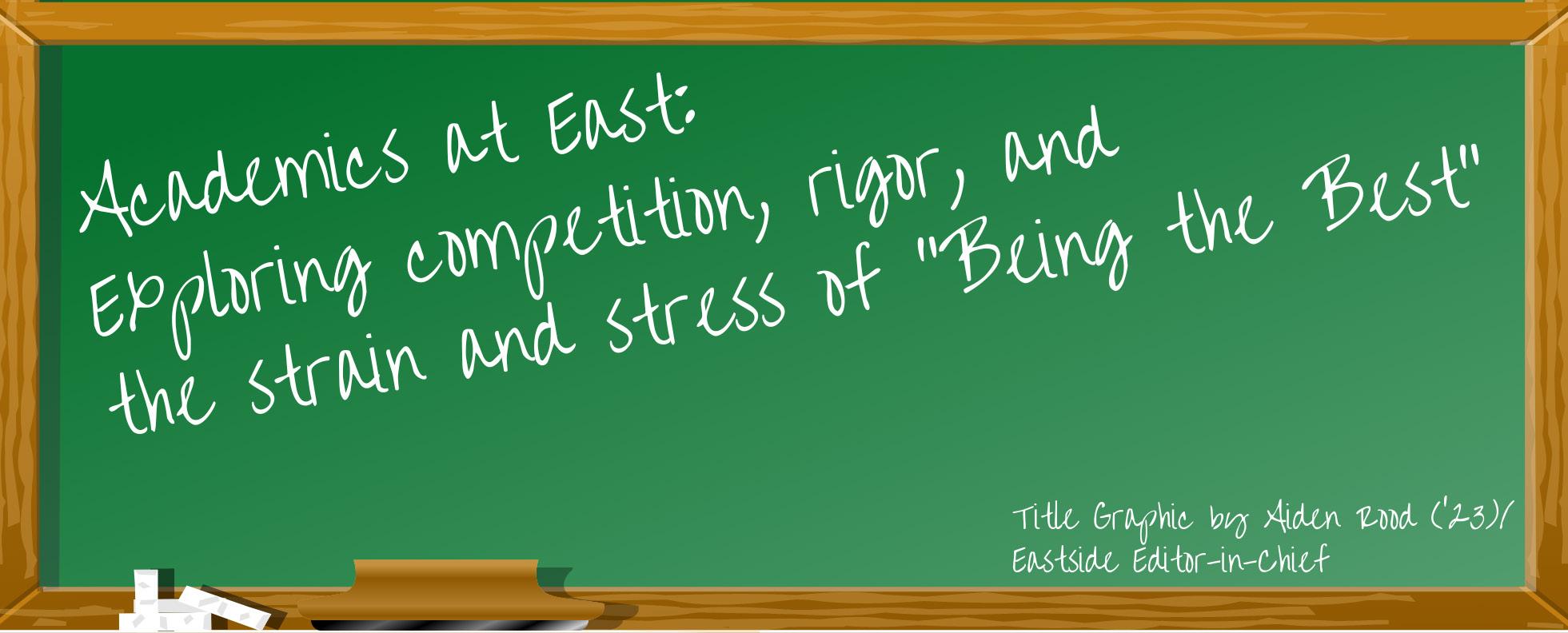
Though the R level classes in the science and history departments were a standard 10 years ago, the administration believes that the removal of “R” level classes benefits students in the long run.
The administration’s decision to remove these R level classes in the science and history department has been controversial over the last 10 years. Some students and staff believe that eradicating the level in specific departments was unnecessary, harming students rather than benefiting them. The general feelings is that R level classes should be reinstated. An Eastside editorial published in 2018 echoed this sentiment, but no change was implemented. That was four years ago.
ing would likely occur. But, if these R-level students are placed in A-level classes where 80% of the people in the course are engaged, those who previously took R level classes are more likely to participate and reap more educational value. Perry believes this is especially true for content-heavy subjects like the science and history classes.
“I don’t think there is any harm in [removing] R-level classes; I think it really benefits our students,” said Perry. His view slightly differs when it comes to more skillbased classes like math and English, where a student must be successful in one class to continue building and learning the skills needed to be successful later in high school. This is where R-level courses are highly beneficial; an educator can pay more attention to the student and guide them through the skill sets needed to be more successful in later classes.
With the removal of R level classes, some have naturally questioned the validity of rigor in East classes. Older students, siblings and alumni say that harder classes are now being “watered down” because of the removal.
tivation to complete it and feeling overwhelmed with other school work.
“None of those reasons to me negates the importance of the assignment. The teacher gave that assignment for one of a couple of reasons. They wanted the child to learn through the activity of the assignment… or they wanted to assess what your current understanding is by the production of that assignment. Neither of those things happen if the assignment never gets done, or done with finality,” said Perry.
If a student is caught plagiarizing,
While I understand the significance of the support towards helping us have opportunities, as there are underlying reasons that back up the motives for plagiarizing, it is important to ensure that students don’t try to keep plagiarizing. The chance to even get to do the assignment is a big change from getting a zero automatically, which I appreciate.
Even so, there should be more repercussions that follow in order for us as students to become more aware of what we can do to make better decisions in the future. Thus, we should keep this policy, but make this a learning experience that is more worthwhile for the moral choices we make to establish our paths of life.
When asked about this disparity, an anonymous senior commented that in the past, some of the easier classes he took had teachers that made classes more difficult compared to students taking the same class at a more intense level. The student noted that this disparity in difficulty specifically pertained to his teachers’ grading scales, class content and more.
Ronak Pathak (‘26), the freshman class president, agrees.
“I am taking several courses at the H level of rigor,” he said. “I actually discussed my classes with friends taking
He explained how, in the past, his accelerated English teacher required him to write an essay early on in the school year, even when honors English students were writing them much later.
Ultimately, the school should work to better address course level disparities. Doing so will ensure that course classification accurately reflects classes’ intensity levels, especially in comparison to higher or lower classifications. It will make selecting one’s class schedule much easier for students and even potentially reduce the amount of students switching class levels at the beginning of the school year.
Dr. Dennis Perry, East principal, explained that if a disinterested and unmotivated learner is pushed into a category of other students sharing similar sentiments, the learning environment would be dull and less learn-
When asked about this, Perry remarked that it has been a decade since the removal of R-level courses, so the basis of comparison has been highly blurred. Student achievement at East has not decreased in terms of standardized test scores, so this removal has benefited East’s academic environment.
“[I think] many of these students [previously] in Rlevel now in [A-level] classes have learned more than if they were in R-level classes,” said Perry.
Editorials represent the views and opinions of the Eastside Editorial Board.
Eastside recognizes the importance of student voice and representation through East and West Student Government Association (SGA) and student voice initiatives, and also urges for consistent transparency from district administration regarding decisions that are made in response to student voice.
Eastside acknowledges instances when district administration listened to student voice and was transparent about its decisions. Past examples include concerns on the middle school level regarding dress code changes being listened to and discussed at Board of Education meetings, resulting in a successful change in district dress code.
Eastside appreciates past measures that district administration has enacted, but underscores that to amplify student voices, administration should also transparently provide accessible reasoning behind all decisions made in light of student voice.
“Student voice is incredibly valuable for input and thought for discussion, but students expressing [their] voice does not necessarily mean that will lead to direct change,” said Superintendent Dr. Joseph Meloche. “Just because somebody had a position about what they said [and] that [wasn’t] the path or decision that was made, does not mean that they weren’t necessarily heard.”
In February 2016 and December 2018, Eastside published two editorials, both criticizing the district administration’s decision to reduce the number of regular-level (R-level) classes
available for students to take at Cherry Hill High School East and Cherry Hill High School West. And yet, despite students and teachers voicing these concerns, over the past four years, not much has changed — and more importantly, not much has been addressed to students on a large scale concerning the reasoning behind the decision.
In other words, only a few students who directly ask may receive reasoning behind decisions, rather than the entire student body. In this case, the administration did not explain the reasoning behind their decision to reduce the number of R-level classes until they were directly asked by individuals in the community, even after both editorials were published.
In regards to incorporating more R-level classes, Meloche said, “We share [Eastside editorials] with the Board of Education… [Often] I’ll have a follow-up discussion with Dr. Perry or Dr. Morton… Again, in the case of the R-level classes, is there something that we can do better to help kids understand or help students understand why this is the path we’ve gone down?”
Beyond the lack of address toward implementing more R-level classes, there was also little response towards the forced East teacher transfers that occurred last year.
Despite multiple Change.org petitions protesting specific teacher transfers, some of which garnered over 1,000 signatures, a school walkout organized by school-wide SGA leaders and Board of Education student repre-
Managing Editor: Abby Yu
sentatives with over 1,000 student attendees and outside coverage from the Courier-Post, 6abc Action News and other press, district administration still did not express their reasoning or address the transfers.
While Eastside acknowledges that personnel decisions must remain private, the reality is that most of those transferred still say they do not know why, which could potentially give the impression that the district does not care about them as people, let alone teachers.
During Board of Education meetings, members of the board are legally not allowed to respond directly to public comments. Thus, the question is posed, does speaking during this time achieve any purpose?
If the Board of Ed. members cannot respond to those who put their voice forward, including the students who spoke out against the teacher transfers, then members should also be more transparent about what public comment actually helps to achieve.
In an Eastside survey regarding the extent to which students felt that administration listened to their voices, 90.6% of the 265 respondents felt that district administration did not listen to or only somewhat listened to student voice; 9.4% said that they felt district administration did listen to student voice.
Eastside would like to advocate for new forms of reciprocal communication between administrators and students so that students are more informed. It is common for some students to reach out to administrators and bring up
their concerns. However, in many instances, these communications are not publicly available.
Eastside proposes that once a cycle, Dr. Perry speaks on the announcements and announces to the student body the issues brought to his attention by students. Another method to ensure that transparency is prioritized is to send an itemized list of administration’s responses to student voice through Outlook once or twice per month.
This list would contain student ideas brought to administration’s attention with a written response from administrators. Thus, both methods would ensure all students have easy access to and are up to date about administration’s response to issues.
Although not all student voice initiatives may reach agreement or compromise with administration, Eastside believes that there should be regular communication between administration and students regardless, whether it be including students during these decision-making processes or making the information from those communications more public and accessible to all students. Transparency for the decisions of the district should not only exist, but also be easily accessible to students.
To be clear, Eastside is not asking that all student opinions be met with amends or resolutions by administration. It is simply requesting that students’ voices are met with public and direct reasoning in hopes of heightened future understanding and communication.
Editors-in-Chief: Brielle Lampf, Aiden Rood, Alena Zhang
Online Editors-in-Chief: Vivian Rong, Lauren Winslow
Adviser: Mr. Greg Gagliardi
News Editors
Jillian Koenig
Izzy Sobel
Features Editors
Emily Boyle
Sophia Liu
Culture Editors
Michelle Bookbinder
Julia Rosten
Community Editors
Gia Gupta
Ellie Noh
Art Directors
Katherine Li
Melissa Vital
Sports Editors
Shayna Oppen
Julia Sitnick
Opinions Editors
Isabelle Berger
Manar Hadi
Global Commentary Editors
Batul El Barouki
Matthew Rentezelas
Media Directors
Natalie Finkelstein
Karina Gupta
Photo Editors
Jiwoo Lee
Lucas Tang
Business Managers
Lauren Greenberg
Molly Grossman
Social Media Manager
Ava Richman
The results of the 2022 midterm elections proved once again that it’s hard to predict how Americans will vote.
No one expected Donald Trump to defeat Hillary Clinton in the 2016 presidential election. In the recent midterms, the surprise was on the Republican side: the anticipated “red wave” did not materialize, and Democrats performed much better than expected. Most significantly, Democrats remained in control of the Senate.
Not all of the results were available on election night. In fact, ballot counts continued for days in Arizona and Nevada, leading some to question the process. Those states were also among the last to report results in the 2020 election. Trump’s allegations that the 2020 election was tainted by massive voter fraud stoked fears on both sides of the political aisle. Democrats told voters that election deniers on the ballot put democracy at stake. There also were con-
cerns about conspiracy activists causing disruptions or intimidation at the polls. Some who were sympathetic to Trump’s claims did not trust the handling of mail-
as they are postmarked on time.
Despite the impatience for results in key states, election officials nationwide re - ported a smooth
streams in ballot counting rooms, further boosted trust in election integrity, officials said. High voter turnout indicated that citizens were engaged and refused to be intimidated. An analysis of the issues driving midterm voters reveals interesting — and almost contradictory — answers. According to CNN, around 75 percent of voters described themselves as dissatisfied or angry about the state of the country, and a similar percentage called the economy not so good or poor. But that high level of dissatisfaction, and President Biden’s low approval ratings, did not lead people to vote out Democrats — the party in power. Although nearly a third of voters said inflation was
their priority, 27 percent of voters named abortion as their top issue, according to a CNN exit poll. While Trump is no longer president, around 28 percent of voters said they cast their ballots to express opposition to him. Seventy percent of voters in Senate battleground states also said their party’s control of the Senate was key to their decision.
Young voters were a huge factor in the midterms. The rate of turnout was typical, but the youth vote was so heavily Democratic that it likely swayed some races. House Democratic candidates won voters under 30 by 28 points, up from 26 points just two years ago.
Voters under 30 seemed to vote significantly more Democratic than those aged 30 to 39.
This election is a reminder that the youngest voters can have a real impact on races.Now that young voters are making their voices heard, elected officials should listen by addressing issues of importance to this group.
On January 20, 2021, Joseph Robinette Biden Jr. took office as the 46th president, and he came into the White House with an extensive agenda for the recovering United States.
Even before President Biden entered office, his win was disputed by states and even by former President Donald Trump, who has attempted and failed to appeal election results from states like Pennsylvania.
However, as President Biden’s term reaches its midway point, the actions of his administration have been marked with controversy.
At the beginning of his presidency, President Biden was focused on the still ongoing COVID-19 pandemic, which began in 2019 and spread across the United States in 2020, causing a nationwide shutdown.
Many of his successes came from his COVID-19 response actions in early 2021, which involved mass distribution of the COVID-19 vaccine throughout the country.
President Biden’s COVID-19 response actions also included controversial efforts to support a struggling economy by signing a $1.9 trillion stimulus package deal. This gave most Americans upwards of $1,400 in stimulus relief checks. The Paycheck Protection Program granted businesses money and extended homeowner protection programs.
Another one of his successful actions involved climate change action during the Spring of 2021.
As President Biden rejoined the Paris Climate Agreement, he signed a $2.3 billion action plan for
three climate efforts.
In addition to these efforts, he proposed a $100 billion Build Back Better Plan; this involved improving America’s energy infrastructure and creating new jobs. Currently, these efforts to combat climate change remain a key concern on his agenda.
The Biden Administration in November of 2021 also passed a $1 billion infrastructure plan into law to create new jobs across the United States by funding state and local governments.
His administration believes this money will help fund crucial public works projects like fix crumbling bridges and roads and to give people better access to the internet.
Midway into 2022, the Biden administration, amidst growing concerns over homicidal gun violence starting in 2020, began to make efforts to pass gun legislation acts.
These acts created tougher background checks and encouraged state implementation of “red flag” laws.
The Biden administration also later implemented stronger gun control laws in the aftermath of the Robb Elementary school shooting, sending $300 million to fund mental health programs and aid schools recovering from mass shooting incidents.
In addition to some of the notable success he has achieved during his tenure in office, President Biden also oversaw many controversial failures during his early administration.
March of 2021 brought about the controversial military withdrawal from Afghanistan, which ended with “more than 100,000 people evacuated and 13 American service members
killed” according to CNN.
This has changed how the United States Pentagon and the Biden Administration would deal with evacuations.
President Biden’s foreign policies were further challenged when the Russian Federation invaded Ukraine in February 2022. At first, President Biden condemned Russia’s actions against Ukraine, calling out the invasion as an “unprovoked and unjustified attack.” However, later on, his administration would send United States troops to defend Ukraine.
Internal politics in the United States were also challenged during Biden’s presidency by the controversial overturning of Roe v. Wade, a 1972 Supreme Court decision that gave women the right to safe abortion access.

President Biden condemned the action, calling the event “a sad day for our country” and urging Congress to act by giving back what President Biden’s administration called a “constitutional right.”
The most recent of President Biden’s major actions in his early presidency included new initiatives in the COVID-19 recovery plan. His student loan forgiveness plans had been struck down by the federal government as of November 11.

The early presidency under President Biden brought about some new changes, many of which have sparked controversy.
Many people claim that President Biden’s COVID-19 actions brought about inflation, rising real estate market prices and causing price hikes.

Others argue that these acts helped Americans struggling with the economic pressures that oc-
curred during the tough period of lockdown.
President Biden’s initiatives for climate change, infrastructure and women’s rights were rife with dispute, particularly between the parties in the divided Senate; they have been close to rejection or were fully rejected.
Other plans such as gun legislation and actions against the Russian
invasion of Ukraine have changed the scope of the tolerance of violence in the United States.
President Biden’s early term has been eventful with new changes and controversies immediately following his inauguration, and only time will tell whether the Biden administration can handle these changes and implement new ones if needed.

Over the past few months, renowned hiphop artist Kanye West has spread increasingly alarming rhetoric on the topics of Nazism and antisemitism.
While we’ve seen some smaller celebrities and public figures voice extremely hateful views in the past, it’s frightening to see hate coming from a person who holds such a dominant grip on American society.
For more than a decade, West has been a media sensation because of some questionable decisions which have been chalked up to mental health issues.
In more recent years, Kanye’s issues have become more violent and targeted in nature, like when he publicly harassed comedian Pete Davidson after Davidson and Kanye’s exwife Kim Kardashian began dating.
In early October of 2022, West continued his downward spiral. West appeared at a fashion show in Paris with conservative commentator Candace Owens, where they both donned shirts reading “White Lives Matter.”
West claimed he was simply trying to bait a negative reaction from the public, but that slogan has been used by numerous neo-Nazi and white supremacist groups.
A few days later, West published a statement on his Twitter account about going “deathcon 3 on Jewish people,” which quickly garnered the attention of millions of people. West also cited the stereotypi
a-Lago estate on November 22. President Trump said later on that he had no idea who Nick Fuentes was leading up to the event, and simply wished to discuss West’s plans to run in the upcoming 2024 presi
nopoulos to be his campaign manager. In the past, Yiannapoulos has made many derogatory and hateful statements against Muslim minorities and women in addition to spreading white-supremacist
While these updates are obviously frightening, West lost the 2020 presidential election by an extreme margin,nering only 60,000 votes out of the 160 million votes cast.
However, having West publicized along with other election contenders does
that he “likes Hitler” and that the Nazis “did good things.” Jones even tried to help preserve West’s image by asking whether West acknowledged the horrific atrocities of the Nazis, but West doubled down in these instances and continued to compliment aspects of the Nazi regime.
In numerous cases, West has decided to use his religious status as explanation for his feelings toward Hitler and the Nazi regime. However, his threats on social media and derogatory comments make it extremely difficult to believe that his praise for Hitler comes from a genuine belief that all humans have the capacity for good.
in sponsorships following the incident, West seemed to quiet down for a few weeks.
However, he eventually met with former President Donald Trump and Holocaust-denying white supremacist Nick Fuentes for dinner at Trump’s Mar-
frightening for American minorities who are most targeted by the rhetoric.
West did announce his plans to run for president in 2024. In addition to announcing his plans, West said that he had invited Trump to be his running mate and invited far-right commentator Milo Yian-
His presence helps make extremists look more rational and helps normalize the views he spews out. The more West can rant about antisemitic conspiracies, the less extreme the views become to the public.
This desensitization of hatred due to overexposure is a significant issue in our society, and West is one of its main perpetrators.
West also appeared on Alex Jones’s show InfoWars, where he stated
Whether West has decided to preach hateful ideology because of a genuine belief or because of a want for attention remains unclear. In either case, his popularity has already proven to be a danger to American politics.
West’s follower counts on various social media apps have barely changed despite his remarks, and white supremacist groups are now protesting with signs that read “Kanye is right about the Jews.”

Citizens in the American political sphere can only hope that West will stop the continuation of his harmful anti-Semitic actions.
Cyril Ramaphosa, who was elected president of South Africa in February of 2015, now faces backlash and the threat of impeachment after a 2020 scandal has resurfaced.
A two-thirds majority from the African National Congress (ANC) is needed in order to begin impeachment proceedings.
As of December 13, 2022, the South African parliament voted a surprising 214 to 148 against impeachment proceedings. However, the scandal has severely damaged Ramaphosa’s image as new details continue to emerge. This scandal has been nicknamed the “Farmgate Scandal.”
Here’s everything you need to know about the recent allegations against President Cyril Ramaphosa:
In 2020, Ramaphosa allegedly hid a large sum of undeclared foreign currency in his sofa at his Phala Phala ranch. This bizarre move quickly caught public attention.
The money was later stolen and Ramaphosa did not report the theft; instead, he tried to hide it by paying off officials and denying the theft to begin with.
During his December 13th hearing, the African National Congress provided him with a three-person panel. A parliamentary report accused Ramaphosa of “serious misconduct.”
Ramaphosa then confessed that there was a lack
of transparency with the source of his money, but he continued to deny wrongdoing.
Following the parliamentary report, a criminal complaint came from Arthur Fraser. Fraser is a former State Security Agency director who was the person responsible for Ramaphosa “getting caught.”
He accused Ramaphosa of lying about the theft of millions of dollars, but Ramaphosa insists the amount does not exceed $580,000.
Ramaphosa also then went on to admit that the theft was payment from selling buffalo to a Sudanese citizen, Mustafa Mohamed Ibrahim Hazim, allegedly in 2019. It still, however, does not make sense that said buffalo are still on his ranch and were never sent.
A parliamentary report noted that “the President abused his position as Head of State to have the matter investigated and seeking the assistance of the Namibian President to apprehend a suspect” after suspects of the theft are said to have fled to Namibia after the incident.
Ramaphosa concluded by saying, “I did not ‘hunt’ for the perpetrators of the theft, as alleged, nor did I give any instructions for this to take place.”
Despite the turmoil this scandal caused for South Africa, Ramaphosa is surprisingly still expected to win a second term of presidency.
After the looting under

Zuma riots in South Africa that scoured the streets, Ramaphosa promised that he would “weed out corruption from the African National Congress.” South African citizens are scared that there would not be a proper replacement and are fearful of another leader that may continue the raids in the city of Zuma.
It is clear that the South African President showed great political failure and many officials are still skeptical of money launder-
ing, but for now, Ramphosa will still be in the running for re-election in the 2024 general election.
The history of allegations, corruption and scandal has been circulating since 2018.
Despite this, Cyril Ramaphosa has been described as a “saving grace” by many members of the South African public since he was elected again in 2018.
He was partially responsible for ending the horrible
system of racial segregation in South Africa known as apartheid, and he is widely respected and viewed as a successful businessman who changed the African National Congress for the better.
While the current information regarding the scanfal remains cloudy, the upcoming 2024 South African presidential elections will reveal whether Ramaphosa will continue the longest presidential term to date in South African history.
Twenty-two-year-old Iranian Mahsa Amini died while in custody of the “morality police” who beat her tirelessly for showing a little bit of hair through her hijab. This sparked total chaos in Iran as women began to protest against the brutality and oppression that women have faced for decades in Iran.
The anti-regime protests that have been going on are the largest the country has witnessed in a very long time.
According to Amnesty International, despite Iranian security forces cracking down heavily on protesters and killing at least 52 Iranian women, this has not kept the women from crying for peace, freedom and civility.
Iranians have been seen gathering in the streets and using scissors to cut off pieces of their hair as they abandon the hijab altogether. This is a message to the state that represents the poor young women who died for just a little hair.
One of Iran’s militias, Basij, has been involved in severe state repression as they have reigned as a parliamentary force of government for four decades after the fall of the U.S.-backed Shah.
They are meant to keep the “women in line.” As the momentum of the protests increased, Basij began invading schools where they would scare young girls and threaten them in order to bring order to an already
furious country. Fifty Shiraz school girls were seen chanting around and heckling the militia men on October 5.
The girls luckily rejected them as they took off their scarves and chased the Basij away from the school.
Monday, October 18, was the most intense day of the protests so far. Women and girls marched down the suburban streets of Teh ran waving their scarves and yelling “Bisharaf” (without honor) and “death to the dicta tor” as they
have happened in the past seven weeks, the state is still exploding with the protest movement.
Iranians believe that wearing a hijab is a form of modesty that should be chosen, not enforced.
The hijab is supposed to represent freedom to live and serve God, not to
The large gap between how the wealthy live and how the rest of the civilians must adhere to the extreme rules is partly why the protests broke out so powerfully.
Now, the protests are not only in loving memory of Mahsa Amini, but also against a tyrant leader of
stances that have led to the current situation,” said Trita Parsi, executive vice president of Quincy Institute.
This clearly ignites some concerns for how the people will continue to face the violent lashes of the regime.
This issue is not only committing crimes to humanity in Iran but also raising concerns across many social media platforms as influencers share heartbreaking videos of the protesters gathering and chanting in the streets.
The U.N. has even made a public statement that they stand with the strong Iranian women who have died for democracy.
At a recent U.N. meeting on November 2, the U.S. sought the removal of Iran from the U.N.’s Women’s Rights Agency. Iran’s 45-member section would be under investigation and would be removed from the movement altogether.
Despite Iranian officials denying the uprising and saying that the U.S. is spreading misinformation, the videos are enough proof to show the world the struggles of the Iranian women.

tore up photos of the Islamic Republic’s founder Ayatollah Ruhollah Khomeini.
The outpouring anger and preemptive fighting for a future where women’s bodies are not controlled by an anti-feminist regime is truly inspiring.
Despite the dangers, threats and deaths that
death sentencing for over 14,000 prisoners that were a part of the protests, but the case will not be published until the final verdict.
The speed of the protests is partly due to economic disparity and decline in the living conditions of the middle and lower class people.
caused ordinary Iranians to seek a better quality of life.
“Women’s freedom is clearly at the center of the protests, but decades of repression, economic misery, government corruption and mismanagement — all amplified by sanctions — have helped create the circum-
According to The New York Times, Rights Groups reported that 250 children and teens have died in the past few weeks.
In the end, human rights are not an issue of the past. The world still faces disparity and has condemned violence against women and their rights to bodily autonomy. These protests will go down in the history of Iran and have already made a significant impact.
Conservative political leader Giorgia Meloni recently became the first female Prime Minister of Italy after being sworn in on October 22, 2022. While this marks an important moment in Italian political history, Meloni seeks to usher in a new era of policies which many critics have deemed as “neofascist” — an adjective that carries considerable weight in the nation’s history. Her party’s goals could inflict extreme damage on Italy’s most vulnerable demographics if instituted.
While she is a relative newcomer to the global political scene, Meloni has been involved in Italian politics since her youth. However, her younger years were marked by political extremism that raises many red flags.
At age 15, Meloni joined the Youth Front of the Italian Social Movement, an organization that controversially supported the leaders and ideologies of Italy’s fascist history.
Later on, 19-year-old Meloni took part in a TV interview in which she praised Benito Mussolini as one of Italy’s greatest political leaders. In 2022, she also labeled Giorgio Almirante, a fascist fig-
ure who produced racist propaganda during World War II, a “great politician.” While some of her questionable decisions as someone younger could be chalked up to immaturity, they still reflect on her character and future as a leader.
After completing her education, Meloni continued to engage in Italian politics. After holding small, local positions in the conservative Brothers of Italy party, Meloni won a seat in Italy’s Parliament in 2006. She continued to gradually climb the ladder of politics, gaining a leading position in her party.
While the Brothers of Italy party takes far-right positions on many topics, its high-ranking members have insisted that its members are opposed to the ideology of fascism.
Meloni’s victory marks the first time the party has held power in Italy, insinuating that Italians are seeking a change to the typical political scene.
Meloni has used this fact to her advantage, promoting the idea that she has been uninvolved in Italy’s top seats of government over the past few years to insist that she represents change.
Meloni, identifying as a Christian conservative, has pledged to follow the motto of “God, family, and father-
land” as leader of her coun try. To achieve these ideals, Meloni has been a staunch supporter of ending immi gration to Italy from Afri can nations.
Meloni has gone as far as suggesting the imple mentation of a naval blockade to stop those attempting to enter Italy by boat.
While Italy has faced rising unemployment issues over the past few years, her extreme rhetoric has many immigrants cur rently living in Italy wor ried.

Many of Meloni’s critics also argue that simply end ing immigration will not solve Italy’s job crisis.
In addition to her an ti-immigration stances, Meloni has taken attitudes against the civil rights of certain Italian groups.
Meloni personally op poses abortion and samesex unions.
While Meloni says that she does not aim to get rid of either of these rights completely, she has taken a strong stance against LG BTQ+ parenting.
Meloni wishes to end the opportunity for LGBTQ+ couples to adopt children or look toward surrogate op tions.
Though her party denies connection to Italy’s fascist past, Meloni’s discrimina-
tory viewpoints present an
people and America must wait to see what Meloni plans for the future of the Mediterranean nation.
To Kristin Wieland: Happy Valentine’s Day!



To Izzy Sobel: All you need is LOVE, but a little chocolate now and then only sweetens LIFE.... Happy Valentine’s Day. You always have our heart!! Love Mom & Dad, brothers & dogs XoXo
To Frannie: my biggest fan From: Dad, your first valentine LY xoxo
Love you, fool. - Bro
Hey Scarlett!!! WTRAB?! - Dude
To Camryn Connelly: Not a day goes by where you don’t catch my eye. From: Secret Admirer
To Michael: You are my heart!!! I love you!! MOM xoxo
HAPPY VALENTINE’S, MICHAEL!!! HPN loves you!!!
Leeor and Natai: We are so proud of you and love you so much. Abba and Yima
To Joshua Gold: Happy Valentine’s Day! We love you soooo much! From Mom and Dad
Ethan Gwara, we are so proud of you and love you more than all the stars in the sky. Love, Mom and Dad
Happy Valentine’s Day, Wyatt!! Lots of love and a big heart, from mom and everyone else
Happy Valentine’s Day to Kay Kay, Ashley and Victoria Buividas. Love you girls so much. Dad
Annjelise, WE Love you -- Mom & Dad

To Cody Zinn: It is unfortunate that they are limiting the number of words for this message; how can I possibly express all of my loHappy Valentine’s Day to the real MVP, Jayden Ramos! Love you always and keep up the great work. Love you! - Mom.


To Abbie Z: Yttrium, Oxygen, Uranium, ARgon, electron, Sulphur, Phosphorus, electron, Carbon, Iodine, Aluminum. Lepton, Iron, Lead, Oxygen, Vana
dium, electron, Yttrium, Oxygen, Uranium!
To Gianna, Gabriella, Gregory, Vance C, and New baby boy bundle, Mommy wants to let you guys know that I love you all and I want to wish you all a Happy Valentine’s Day!
To Brett Mooney, know that I love you and am so proud of all you do! Love, Mom
To Mia Bayona. From Mindy, Bodie & Mr. B. Sorry we’ve been confusing your bed with a toilet. We heart you.
Happy Valentine’s Day to Shia. We are so proud of you and we can’t wait to see what you do next. You are so loved.
To Nicole Drebick, Being yours is a dream come true. Happy Valentine’s Day! From, Nick Grant Ella G... We’re so proud of you! Your dedication and passion for Eastside is amazing! Your love for Darwin is adorable! Love, Mom & Dad Marvin, you make me so proud. It is an honor to be your mom. Thank you for being the best son a mother can ask for. Love you more than words can say, From mom.
To: Brandon & Payton Reeves From: Mom & Dad
Hope your day is filled with fun and your mouth is filled with chocolate! XOXO
Happy Valentine’s Day to Michael McCurdy, Love Dutch and Luna xoxo
Sharing THANKS and appreciation to all Cherry Hill East teachers and staff!
SARAH M B., we’re very proud of you. Keep on striving! Luv M&D
To Sadie Casper-Richardson, Happy Valentine’s Day! From: Mom.
Sending hugs and kisses to our sweet Senior! Happy Valentine’s Day, Natalie! Love, Mom & Dad
After months of anticipation, Disney finally announced its biggest projects coming in 2023. From new live-action films, to animation spin-offs, Disney fans are eager ly awaiting these to pre miere.
The biggest announcement from Disney was the release date and the first trailer of the live-action “Little Mermaid.”
Swimming into movie theaters on May 26, 2023, Halle Bailey will star as Ariel, Melissa McCarthy as Ursula and Jacob Tremblay as Flounder.

In the trailer, fans got a
preview of Ariel, a glimpse at the set and an overall teaser for the music. As an African American actress, Bailey will break boundar ies as the first Black wom an to play Ariel along with line. This magical film is predicted to be released sometime in 2023 on Disney+ in order to coincide with the original
release date.
not yet been released but is expected sometime in 2023.
Fans are feeling emotional after the announcement that Disney and Pixar will make a sequel to the beloved “Inside out,” titled “Inside Out 2.”
tional and optimistic feel while introducing new emotions and following Riley as a teenager. It will premiere in theaters on June 14, 2024.
journey to be ing the “Lion King.” Predicted to be an emotional and inspirational movie, it will be in theaters on July 5, 2024.
With “Snow White and the Seven Dwarves” being Disney’s first animated film, the live action is rumored to have some “old Disney” parallels to preserve the classic storyline. Set for release on March 22, 2024, Rachel Zelger will star as Snow White, along with Gal Gadot as the Evil Queen.
A preview for this has
The original is based on 11-year-old Riley. With the news of find out she has to move, Riley’s emotions, Joy, An ger, Fear, Sadness and Dis gust, are intro duced as charac ters.
Throughout the big changes in life Riley is go ing through, her emotions try to control and gear her in the right direction. The sequel is expected to follow the original’s emo-
Created by the director of “Frozen,” “Wish,” an animated musical, will be released in November 2023.
Following Disney’s iconic “wish upon a star” motto, “Wish” is a film about a young girl named Asha, who has a unique connec-

With Julia Michaels as songwriter and Ariana DeBose as the voice of Asha, this is deemed to be a five-star film. Although some announcements involve movies that are more than a year away, fans are looking forward to seeing them premiere and watching the Disney magic unfold in new ways.
Art by Melissa Vital (‘23)/ Eastside Art DirectorAll across the globe, Jennette McCurdy is notoriously recognized for her role as Sam Puckett in Nickelodeon’s teen sitcom, “iCarly.” However, despite her stardom as a child actor, McCurdy never had a passion for acting at all.
In her memoir, “I’m Glad My Mom Died,” McCurdy breaks down her brutal experience growing up in the television industry in addition to the pressure and abuse her mother inflicted upon her.
When “I’m Glad My Mom Died” was released on August 9, 2022, the book immediately began turning heads with its blunt title. The honesty shown on the cover of this book continues throughout the rest of her story as McCurdy touches on the harsh realities of eating disorders, OCD and sexual assault. Readers admire McCurdy’s ability to not veer away from sensitive subjects, landing this book immense amounts of praise.
“I’m Glad My Mom Died” quickly became a New York Times Best Seller, selling over 200,000 copies internationally in its first two weeks. McCurdy’s memoir focuses on her desire to always please her mother.

McCurdy frequently lied to make her mother happy about anything from birthday gifts to nutty coconut ice cream. Her mother had dreamed of becoming an actress when she was younger, so she forced that dream on McCurdy and made her start auditioning.
In one instance, McCurdy expressed to her mother that she did not want to continue acting, but her mother told McCurdy that her feelings
were invalid, so she continued auditioning.
As McCurdy began to mature, her mother tried
everything to maintain her youth. McCurdy realized that having a youthful appearance led to more job opportunities in the industry, so she went along with her mother’s suggestions like calorie restrictions.
McCurdy began to radi-
cally limit what she ate, and due to her OCD which her mother chose to ignore, McCurdy ended up weighing herself five times a day. These restrictions manifested into anorexia and bulimia to fit into her mother’s ideal image of her.When McCurdy finally landed her most well-known role of Sam Puckett, she also underwent additional pressure from “The Creator,” who is theorized by audiences to be the show’s director, producer and writer, Dan Schneider.
He encouraged her to drink alcohol while underage, and allegedly demanded photos of her from the costume department. During this time, McCurdy’s
mom also obstructed her independence by accessing her income, emails and diary.
Despite all of her mother’s abusive and manipulative actions, McCurdy supported her mother and prayed for her health. Her mother grappled with cancer, sometimes even blaming McCurdy for her predicament. However, for every birthday leading up to her mother’s death, McCurdy wished for her mother to live another year.
When McCurdy finally started therapy in her adulthood, she attempted to defend her mother’s wrongful actions. Eventually, McCurdy came to terms with the trauma her mother inflicted and decided to focus on her healing journey.
“I’m Glad My Mom Died” masterfully shares McCurdy’s struggles with her relationship with her mom along with her body. Her story inspires audiences through its openness and truth. Today, McCurdy is on a hiatus from acting and instead focuses on her own passions such as writing.
Christina Aguilera. Adam Levine. CeeLo Green. Shakira. Usher. Gwen Stefani. Pharrell Williams. Alicia Keys. Miley Cyrus. Jennifer Hudson. Kelly Clarkson. John Legend. Nick Jonas. Ariana Grande. Camila Cabello.
One thing all these artists have in common is that they have served as coaches on NBC’s hit singing competition show, “The Voice.” However, none have served as a coach as long as Blake Shelton, a staple character on “The Voice.”

On October 11 of this year, Shelton announced on Instagram that his reign as a coach for over a decade
will be ending after the upcoming 23rd season. Shelton was one of the original judges on the show, which first aired in 2011.
“This show has changed my life in every way for the better and it will always feel like home to me,” wrote Shelton.
Currently, Shelton holds the most wins, eight, out of any other coach, with Kelly Clarkson coming in second with four wins. Shelton successfully guides contestants after the blind auditions through battle rounds, knockouts, playoffs and live performances so that they have the best shot of winning in the end.
While most winners do not become big names in the music industry, two of
Shelton’s winners, Danielle Bradbery and Casadee Pope, have. Both singers have also followed in the footsteps of Shelton and are a part of the country music industry.
Not only did Shelton succeed with his contestants, but he also created a great friendship with host Carson Daly and even met his wife Gwen Stefani. Outside of “The Voice,” Shelton has had a successful country music career of his own.
Now, Shelton plans to move forward in his career with a new game show called “Barmageddon,” which will feature Carson Daly and former WWE Superstar and Hall of Famer Nikki Bella. Bella has already had experience on
TV through shows such as “Total Bellas,” “Total Di vas” and “Dancing with the Stars.”
Viewers can expect to see some of their favorite, or least favorite, celebri ties in every episode. The basis of the show is that two “infamous” celebrities will come on every episode in order to be redeemed. They will complete a set of five games in Shelton’s bar, Ole Red, in order to receive points, but they can receive extra points by spinning the Wheel of Redemption.
While Shelton will be sad to leave behind “The Voice,” he is excited to embark on a new journey with “Barmageddon” and to continue bringing entertainment to audiences.

After an excruciatingly long five-year wait, SZA triumphs with her sophomore album “SOS.” This highly anticipated 23-song album displays an emotional journey of introspection. Some songs contain featured artists, such as “Ghost in the Machine” with Phoebe Bridgers and “Used” with Don Toliver, while others present SZA by herself.
She even features an unreleased verse by the late Wu-Tang member Ol’ Dirty Bastard in the last track of the album, “Forgiveless.”
In the past, SZA wasn’t afraid to experiment with her music production and deviate from traditional pop songs and R&B structure, and “SOS” is no exception.
Each track on “SOS” delivers a uniqueness and explores different genres of music. For example, in “Smoking on my Ex Pack,” SZA brings back the feel of classic mixtapes by amusingly insulting all of her exes over a high-pitched soul trap.
Following that, “Ghost in the Machine,” featuring Phoebe Bridgers, is a hauntingly beautiful and melodic song that delves into the search for emotional deliverance. Right after that is “F2F,” a poprock country song about revenge.
Through these distinctive tracks, SZA exhibits her versatility sonically and production-wise.

Unlike her first critically
acclaimed album, “CTRL,” where she heavily incorporated monologues and discussed her struggle of re-
ways to cope with losing her loved ones.
With the smash-hit song “Kill Bill,” she sings about
thing as control; however, she continues to make an attempt to grasp and make the most of her animosity in
tender song “Special” by singing about her body dysmorphia, regrets and current insecurities.
“Forgiveless,” featuring Ol’ Dirty Bastard, showcases a more confident and fiery side of SZA, which pleasantly closes the album after the vulnerability of the previous tracks.
Although SZA delivers an incredibly produced and meaningful album, few fans exhibit some negatives such as the album being excessively long and the instrumentation being too shy.
Many fans were also disappointed with how long the album took to come out, as many of the songs have been leaked years prior to the release.
However, SZA kept her supporters satisfied with early releases of tracks like “Good Days,” “I Hate U” and “Shirt.”
She’s also teased that a deluxe version of “SOS” will come out very soon and potentially more songs with heavily anticipated features.
taining control of life, SZA explores the five stages of grief throughout the album and delineates her ability to grow and accept herself. She learns how to alleviate the toxicity in her life, and she examines different
killing her ex in order to find happiness as “if [she] can’t have [him], then no one should.”
“Seek & Destroy” refutes the ideas SZA carried in “CTRL” through her realization that there is no such
an effort to better herself.
This is clearly stated in the line “no control,” which can also allude to the idea that the “CTRL” era has ended.
SZA displays susceptibility in the spectacularly
Regardless, SZA did not disappoint with “SOS.” This album is an amalgamation of beautifully melted music styles that blend with relatable lyrics and a much more empowering voice. It’s an album that features at least one track that anyone can connect with.
Whether it’s about letting go, feeling vulnerable about your insecurities or discovering individuality, SZA perfectly encapsulates the journey of self-discovery in “SOS.”
The ever-popular “Dancing With The Stars” concluded its 31st season on November 21, 2022.

This sea son differed from the previous thirty in that the show aired on Disney+ rather than on ABC.
“Dancing With The Stars” is the first live show on the streaming service.
The season kicked off on September 19, 2022, with 16 celebri ties and their dance partners.
This season’s cast included TikTok star Charli D’Amelio, “Bachelorette” star Gabby Windey, actor Wayne Brady, drag queen Shangela, actor Daniel Durant, actor Trevor Donovan , “Jersey Shore”
star Vinny Guadagnino, social media personality Heidi D’Amelio, singer Jordin Sparks, singer Jessie James Decker, bodybuilder Joseph Baena, actress Selma Blair, “Good Morning ica”
gist Sam
deaf, competed with his partner Britt Stewart and made it to the semi-finals.
Including Durant, “Dancing With The Stars” has had three deaf celebrities as contestants.
During week nine, Durant gave viewers the opportunity to experience dance the way that he does. During their dance to the song “Enjoy the Silence,” the music cut out Durant and Stewart dancing in silence.
“I just want to show everyone where I’m from and what I’ve been through to get here…I got to show the world I’m successful and you can be successful no matter what,” Durant said after his silent dance.
that happened in Colorado Springs. An attack on the LGBTQ community cannot be supported, cannot be loved. This moment right here is about sharing more love and less hate and hope we can start celebrating our differences.”
Along with Shangela and Durant, Selma Blair was also a special contestant. Best known for her role as Vivian Kensington in “Legally Blonde,” Blair competed with her partner Sasha Farber.
yl Ladd, “The wives of New Jersey” star Teresa Giudice
“CODA” star Daniel Durant broke down barriers during tion. Durant, who is fully
However, Durant was not the only unique star this season. Shangela danced as the first drag queen celebrity on the show. She and her partner, Gleb Savchenko, made it to the finale and placed fourth in the competition. Shangela and Savchenko impressed the judges throughout the entire competition with their energy-packed performances.
Shangela made it her goal to represent the LGBTQ+ community throughout her time on the show.
After her performance in the finale, Shangela gave these words to the viewers: “There was a mass shooting, a horrible tragedy,
In the season premiere of the show, Blair spoke about her diagnosis of multiple sclerosis (MS) in 2018. Although the disease gave her numbness in her left leg, Blair fought through the struggles and made it to week five of the competition.
Unfortunately, she chose to stop competing after week five due to health concerns related to her MS.
“I just want to say that I loved this and sometimes there’s going to be uncomfortable things for you to do in life and you just do it with a smile,” Blair said before leaving the show.
After ten weeks of difficult training, the four remaining contestants made it to the finale episode.
Charli D’Amelio, Shangela, Gabby Windey and Wayne Brady remained in the competition until the end.
After final performances
from each of the remaining contestants, Shangela came in fourth place, Brady in third, Windey in second and D’Amelio was crowned the winner. Only 18 years old, D’Amelio serves as one of the youngest winners in the show’s history.
The end of season 31 also brought about the end of judge Len Goodman’s time on the show. Goodman has served as a judge for the competition since the series began in 2005.
The 78-year-old judge decided that this season would be his last as he would retire next year.
Also leaving the show after this season is two-time “Dancing With The Stars” winner and professional dancer Cheryl Burke.
This season, Burke danced with Sam Champion, and they were eliminated after week four. Burke has been on the show for 25 out of the past 31 seasons but decided it was time to retire.
Overall, season 31 proved successful with its new home on Disney+. With the conclusion of this season, viewers look forward to seeing what will come in season 32 next year.
Notable Past Winners:
2013: Amber Riley
2014: Alfonso Ribeiro
2016: Laurie Hernandez
2017: Jordan Fisher
2018: Adam Rippon

Some know her as Rachel Berry. Others simply know her as American actress and singer Lea Michele. However, many now know her as Fanny Brice.
On July 11, 2022, the Broadway production of “Funny Girl’’ announced that Lea Michele would be joining its cast as the lead, Fanny Brice. Michele took to Instagram that day and posted the announcement. Along with the post, she wrote how “a dream come true is an understatement” in regard to stepping into this major role.
“Funny Girl” was revived on April 24, 2022, with actress Beanie Feldstein cast as Fanny Brice. Soon after opening, Feldstein wrote on July 10 on Instagram “production decided to take the show in a different direction,” and she then “made the extremely difficult decision to step away sooner than anticipated.”
Michele was quickly cast as the new Fanny, and she made her debut in the production on September 6, 2022. The pressure is on for Michele, as Fanny Brice is such a highly-acclaimed role originally made famous by Barbra Streisand in 1964. Streisand won multiple awards during her tenure as Fanny; therefore, it seems like Michele has some big shoes to fill. The actress has much talent to bring to the table, so fans of the Broadway show are excited to see if Michele will
live up to Streisand’s success. There has been much buzz and excitement surrounding Michele undertaking the role of Brice due to the journey she has taken to get there. The actress grew up on Broadway, initially landing a role in “Les Miserables” in 1995 at the age of nine, followed by a role in the 1998 original production of “Ragtime.” Michele was then given a role in “Spring Awakening” from 2006 to 2008, which she eventually left to pursue her biggest opportunity: “Glee.”
Michele starred as Rachel Berry on the hit Fox musical comedy from the time it aired in 2009 to the season finale in 2015. “Glee” truly showcased Michele’s talent, as she portrayed an aspiring, yet rather annoying, high school girl who dreamed of becoming a Broadway star. With ballads, duets and solos in group performances,
“Glee” displayed Michele’s talent on the screen, and viewers could truly see her full potential.
Marie Ware, the actress who played Jane in season 6 of “Glee,” responded to Michele’s post by tweeting “Remember when you made my first television gig a living hell?!?! Cause I’ll never forget.” Five years following the finale of “Glee,” Ware came out and made it known to the public that Michele had made multiple microaggressions to her on set.
Upon acquiring the role of Brice, it seems as though Michele has attempted to put her past behind her. However, she was recently thrust into the spotlight on the social media app TikTok where she was trending for weeks. As a result of her limited education due to her Broaodway-centered childhood, a conspiracy theory from 2018 resurfaced that she is illiterate. Michele attempted to “get in” on the joke by teasing herself on her personal TikTok account. Since she has not formally disputed the theory, fans are left to ponder the truth behind the actress.
Prior to being cast as Fanny Brice in “Funny Girl,” most would say that Rachel Berry was Michele’s most acclaimed role.
Although Michele’s singing talent is exceptional, she has secured herself a rather negative reputation in Hollywood. In June 2020, Michele tweeted in support of Black Lives Matter following the murder of George Floyd. Samantha
From the time that Michele spent in the limelight up to this point, she has not been involved in any television or movie productions, and her last major televised role was that of Rachel Berry on “Glee.” Much speculation surrounds the reasoning behind Michele’s limited activity in the spotlight in recent years, and while COVID-19 could be a major reason, the singer’s reputation could have seriously harmed her acting opportunities.
Although controversy has followed Lea Michele for the duration of her Hollywood career, she has once again found success on Broadway with this new role. Perhaps Michele will reclaim the title of “The Greatest Star” with her role in “Funny Girl” as Fanny Brice. Her fansand TikTok - will be closely watching.

Broadway’s longest-running show, “The Phantom of the Opera,” will be coming to a close for its final performance on February 18, 2023.
“The Phantom of the Opera” has been a symbol for musical theater in the Broadway world for years, and it saddens people to see the spectacular show close after almost 35 years. In the 1980s, Andrew Lloyd Webber, the composer; Harold Prince, the director; and Cameron Mackintosh, the producer worked together to create “The Phantom of the Opera.”

The show is based on the French novel, “Le Fantôme de L’Opéra” by Gaston Leroux. Characters in “The Phantom of the Opera” tell the audience a story about the secretive opera lover shielded by a mask who supposedly haunts the Paris Opera House.
This man develops an obsession with a female soprano, Christine Daaé. He masks half of his face to hide the deformities within his skin, for he fears Christine will not love him based on his appearance.
People gain suspicion about a ghost roaming around the house when they begin finding dead bodies throughout the
building.
One night, a large chandelier drops onto the floor and startles everyone. The Phantom impulsively decides to kidnap Christine and forces her to marry him against her will. If she refuses, he will kill another innocent soul.
This excellent Broadway show is coming to a close “because the production costs for a show like Phantom are simply too large,” wrote Emma Halper for 34th Street.
After the COVID-19 lockdown, many businesses struggled to get back on their feet, Broadway included. This show, in particular, wasn’t selling enough tickets to cover the high production costs, which have increased recently due to inflation. Therefore,
“The Phantom of the Opera” will perform its last show on Broadway on February 18, 2023.
“The Phantom of the Opera” has been such a breathtaking show for audiences all around the world. This show is seen as a major piece of art in Broadway history that portrays musical theater aspects and details.
“On Broadway alone, the musical has played an unheard of more than 13,000 performances to 19 million people at The Majestic Theatre (245 West 44th Street),” according to Team Broadway World.
The show opened to the
public on January 26, 1988, and starred the amazing
is available to watch on online streaming services.
Although “The Phantom of the Opera” is most popularly seen on Broadway, it is also shown in dozens of other cities and states.
In total, “the show has been seen by more than 145 million people in 183 cities around the world; it has been performed in 17 languages, and next year, that number is expected to rise to 18, when the Mandarin production opens,” wrote Michael Paulson in the New York Times.
This Broadway show reaches a diverse audience and gives people who speak different languages the ability to watch the show.
The Broadway-loving community is deeply saddened by the news that “The Phantom of the Opera” won’t be performed on the Broadway stage anymore.
After almost 35 years of performing, “an estimated 6,500 people (including 400 actors) have been employed,” according to Team Broadway World.
actors/actresses Michael Crawford, Sarah Brightman and Steve Barton. The show has only evolved from the first performance, and it was even made into a movie which
“The Phantom of the Opera” has, and will always light up the stage with its talented actors and actresses whether it is being shown on the Broadway stage or not.
Art by Mira Wang (‘25) / Eastside Staff












February 2023
EASTSIDE Page 23

Colder weather and shorter days are sure signs that East is in the depths of its winter sports season. Here is a mid-season report on this year’s winter sports lineup at East.
The Cougars had an exceptional season last year, going 28-2 and finishing the season with the best record in school history. After a dream run, East lost to Lenape in the NJSIAA Tournament, Final Round, South Jersey, Group 4 championship game. So far this season, the boys’ basketball team’s record is 10-4. Coach Dave Allen is leading the team again this year. Key players to watch are Josh Fadahunsi (’23), Jack Flannery (’23), Chris Delgado (‘26) and returning varsity player Ian Gross (’23). The young team is learning how to play without last year’s seniors that were influential to the team.
Their plan to succeed is by “keeping the same routine and working hard and trying to replicate last year,” said Gross.
The East girls’ basketball team’s record is currently standing at 3-8. Mr. Bernie Hyson has returned to coach again this year. A key player to watch is Lily Quintero (’24), who is leading the Cougars in points. Runner up for top points is Humna Hussain (’24).
Something important that the girls did was practicing with each other prior to the season, starting to get comfortable with each other.
“Before the season start-
ed we did summer practices so we knew how to play with each other more and we had some type of bonding because it is hard to start off the season without any connection,” said Quintero.
Boys’ Bowling
While many key players graduated and the Cougars finished with a 9-6 record last season, several solid returning bowlers are strong contenders in the division, including Lee Bloom (’23) and David Tribble (’23), who both represented East at the Olympic Conference Tournament last December. This season their record is currently 6-2-1. With new head coach Mr. Ryan James leading the boys’ team and several JV players joining the varsity roster, there is an adjustment period, but the team is hopeful about the rest of the season. The seniors are making a strong effort to unify the players and there is a lot of team spirit and optimism.
“We have a lot of experienced bowlers now and we see it in the score sheet,” said Tribble.
Having finished third overall in the OlympicAmerican division with a 4-8-1 record last season, the Cougars are looking to make it to sectionals this year. The girls’ team’s record right now is 6-2-1. James is also coaching the girls’ team this year. With a roster that includes five varsity players returning for their senior year, East is an experienced team that is ready to take their play to the next level. Players to watch include Leanna Lescano (‘26) and Brielle Lampf (’23). The team likes
to keep a positive environment at matches and can often be heard doing East chants.
“We want to bring a little more attention to our sport… We are trying to unite everyone who is bowling this year,” said Lampf.
Boys’ Swimming
East boys’ swimming won the 2022 NJSIAA Group A State Championship to cap off a perfect 13-0 undefeated 2021-2022 season. Currently the Boys’ Swimming record is 6-0. While many seniors were crucial contributors to last year’s title, several important swimmers are returning to the roster and there is a lot of depth coming in, too. Key swimmers to watch include Jack Behm (’24), Ryan Cortes (‘23), James Tao (‘23), Jack Kramer (’23) and JD Moyer (’24). The team has a tight bond, a strong work ethic and great chemistry. It plans to use these strengths to help everyone as a whole step up and work their hardest.
“The end goal is state championships… we want to continue to win,” said Kramer.
Girls’ Swimming
Cherry Hill East Girls’ Swimming (CHEGS) achieved a stellar 11-2 record last season, ending in a heartbreaking loss to Westfield at states. This season their record is 6-1. The girls are hard at work in the pool with the goal of taking home their sixth sectional championship this year. This is an experienced team with 12 seniors, and each swimmer provides a different contribution to the team’s success. Longstanding coach Ms. Anita Bowser returned to lead CHEGS again this year.
CHEGS swimmers are always close and push each other to be the best they can be. The girls know that they have what it takes to win another championship, and they are working towards that goal.
“I think this is going to be our best year yet… We want another state championship, we want that trophy, and we are not going to give it up,” said Emily Fekete (‘23).
The boys’ track team is anticipating another big indoor racing season this winter. Last season was filled with exciting wins at sectionals, states and the Meet of Champions, and it ended with the Cougars 4x400 relay team placing 14th at the Nike Indoor Nationals. Coach Mr. Anthony Maniscalco returned to winter track to coach distance runners with coach Ms. Yanell Joseph for sprinters and coach Mr. Mike Surrency for throwers and jumpers.
Key runners to watch are Peter Tepper (’23), Trey Shaw (’23), Ben Matthews (’25), Raine Guidarelli (’24) and Ari Greenberg (’24). Tepper thinks, with the team’s strength and how they are looking so far this season, it won’t be surprising if East sends relay, distance and sprinters to important meets again this season.
“I still think we can have a bright future for the 4x400 even with having a few people graduating,” said Tepper.
The girls’ track team came out strong this season and keeps on improving. The 4x400 relay is making a mark as well as many more relays. Last season,
the standout 4x800 relay team placed seventh at the New Balance Indoor Nationals and broke the record for East. With many of last year’s seniors graduated, there are many new additions to the roster. Key runners to keep looking out for include Lexi Tepper (’23), Cate Feudtner (’25) and Nadia McGinnis (’24). Coaches Maniscalco, Joseph and Surrency are also coaching the girls’ team. With many new people on the team, some relays were built.
“I feel like our team is really strong in the relays because we are very team oriented,” said Kramer.
The boys’ wrestling team’s current record is 1-8 with returning coach Mr. Mike Brown. After completing back-to-back years of training without disruption, this team of experienced varsity wrestlers has the right mentality to compete. Players to watch include Mo Sample (’23), Ryan Boyle (’23), Tobi Cero (’23) and Brad Weinberg (’23). The boys have confidence in their roster, have played multiple sports together for years and work well as a team.
“It’s an individual sport, but a team sport at the same time. We all just support each other,” said Weinberg.
Maya Hemo (’23) won the 2022 NJSIAA Girls’ Wrestling State Championship (126-Pound) last season. She also became the first ever girls’ wrestling state champion for East.
In addition, Hemo achieved a near perfect 21-1 record for East last season and so far this season her record is 10-2. Coach Mr. Steve Ascola returned to coach the girls’ team with an expanded roster of eight wrestlers. Hemo is proud of her title, continues to work on her skills and is excited to help the program grow.
“My goal is just to get better… better as an individual in the sport and to help the newer girls that are coming into the sport,” said Hemo.
East athletes are in the thick of another great winter sports season. Each team is working hard and continues to prepare for their big games, matches and meets.
“The magic is in the work.”
Mr. Dave Allen hopes to burn this quote into each of his players’ minds as they play for him and as they grow up. Allen is a special education teacher at Cherry Hill High School East and a basketball coach who has continuously brought East successful seasons.
Last year, Allen led the East basketball team to a 28-2 record.

Allen is also known for forming tight relationships with all of his players and students.
“Our relationship is a special relationship… It’s something that [long-time East coach] Coach Valore built, he built it as a symbiotic relationship like a partnership that you’re going to care about the players when they’re outside the season and when they move onto college.”
Allen described his team as a “tight-knit group of guys in our program.”
Allen has been at East since 2010 and has coached the basketball team since 2011. He attended East as a student and grew up playing basketball in Cherry Hill. Allen played for Valore and considers the legendary former East coach to be his inspiration.
“Valore wanted somebody who was a former player to be the coach to
carry on his tradition that he established here when he got here in 1967,” Allen said.
Allen wasn’t always sure of what kind of teaching he wanted to pursue. In college, he considered English, history and physical education. He figured that in order to become a coach, teaching physical education was the way to go. That changed when he got advice from an old friend.
“Coach Valore steered me in the direction of being a special education teacher,” Allen said.
Overall, Allen looks up to Valore and wants to make him proud as he continues what Valore started.
Allen said, “He is one of the greatest teachers I’ve ever been around, one of the best educators I’ve ever been around, and one of the best coaches I’ve ever been around… He understands education better than any-
one I’ve ever been around.”
Allen wanted to play basketball for as long as he could. He loves to watch, play and just be surrounded sports. He also considers himself an extremely competitive person.
“Coaching has allowed me to compete and win, which is what I really, really love” Allen said.
When asked about the success of his program, he talked about the players’ ability to work harder than anybody else.
Allen said, “We’re a program that has good talent, but we’ve got great kids from great families and that combination has definitely contributed to our success.”
Allen talked about the things he loves about working at East and doing his job, saying, “The opportunity to come back here and teach and coach at Cherry Hill East where I went to school with the community I grew up in and what it did for me as a student and as a
person and to have the opportunity to interact with different students… it’s just a super environment to work in and be a part of.”
Allen hopes that he has inspired his students and players over the years.
“What a young person needs is someone to believe in them, and I want to be able to be somebody to affirm kids and give them confidence, which has always been my goal and I hope I have been able to do that,” Allen said.
 ■ By Brielle Lampf (‘23) Eastside Editor-in-Chief
■ By Brielle Lampf (‘23) Eastside Editor-in-Chief
For many sports-crazed fans, the big dream is to play for their favorite professional sports team, or perhaps pursue a career in sports medicine. For others, it’s to make it big in the world of sports journalism.
Greg Frank (‘13) is committed to following this journalistic path.
Frank first started down the sports journalism path in high school, when he was a sports editor for Eastside, and following his time at Cherry Hill East, he committed to Temple University, where he would eventually discover his passion for radio.
While at Temple, Frank got his first job on the radio at WIP radio in Philadelphia. He was mostly doing promotion work, but it never detoured him from wanting to pursue a career in broadcasting.
After graduating from Temple in 2017 though, Frank was faced with a difficult and common question that many college graduates are faced with across the country.
Frank asked himself this: “Do you want to try and move around and get a guaranteed on-air job right out of school?”
The answer to his question was yes, though there are a lot of people who opt to stay in the area after graduating from college.
“When I decided to move to a small-town in Minneso-
ta, it was a difficult social and mental hurdle to clear, but once I realized this is the right thing to do, I don’t regret it for a second now,” said Frank.
While Frank had received multiple offers from surrounding areas in Philly, none of them allowed him to do what he wanted to do in sports journalism. Most would have him doing technical work, or promotion work behind the scenes, something that he already had experience with, but wasn’t his goal.
Wild 102 Radio in Roseau, Minnesota, was Frank’s first job out of college. Here, Frank got air-time, albeit relative to local area sports. Frank would spend the next four years at Wild 102 paying his dues, as he called it, but soon enough, another job opportunity opened up.
SportsMap radio, a station based in Houston, Texas, reached out to Frank in the fall of 2021 offering a position. While at first, Frank was doing utility work behind the scenes once again, it wouldn’t remain that way for long.
Doing a radio show isn’t as simple as it seems. Besides going on the air and speaking for hours at a time, the host needs to know which segments fit into certain time slots. With new media outlets updating circuits 24/7, even while
on air, the host needs to be checking news feeds to see for any major updates. Besides that, for Frank, he has about an hour and a half of prep time before the show even starts. Oftentimes, Frank is asking himself the question of whether he should lead with the most exciting news, or spread it out throughout the duration of the show.
Most importantly, Franks said to “be comfortable with a level of unknown.”
It is a necessity in the world of broadcasting, as anything can happen at any time, and a broadcaster needs to be prepared for it.
Now on SportsMap radio, Frank is hosting from
1 to 4 p.m. Eastern Standarard Time in the afternoon on their radio network with co-host Fred Faour. Those two people have a camaraderie that extends beyond the show, often talking about Philadelphia versus Houston sports.
“I wake up every day excited to go to work, excited to talk sports, excited to see coworkers,” said Frank.
What started off as a simple love for sports games has turned into a full-time job after a long journey. From Philadelphia, to Minnesota, to Houston now, Frank still says he has future goals.
“My dream is to make it back and be hosting in Philly, even just one talk
show,” said Frank.
Unlike in the Northeast regions, a lot of other places across the country, like rural areas, don’t have as much of a fan base as densely populated cities. Frank hopes to be where the excitement is, and he believes that the fan base in Philadelphia is ideal.
When asked simply what his future looks like, he responded with, “I want to keep going.”
What that looks like is still up in the air, whether that be on a radio station in Philadelphia, or another station with an engaged audience, he doesn’t know yet.
What is apparent is Frank’s love for sports and his determination to succeed.